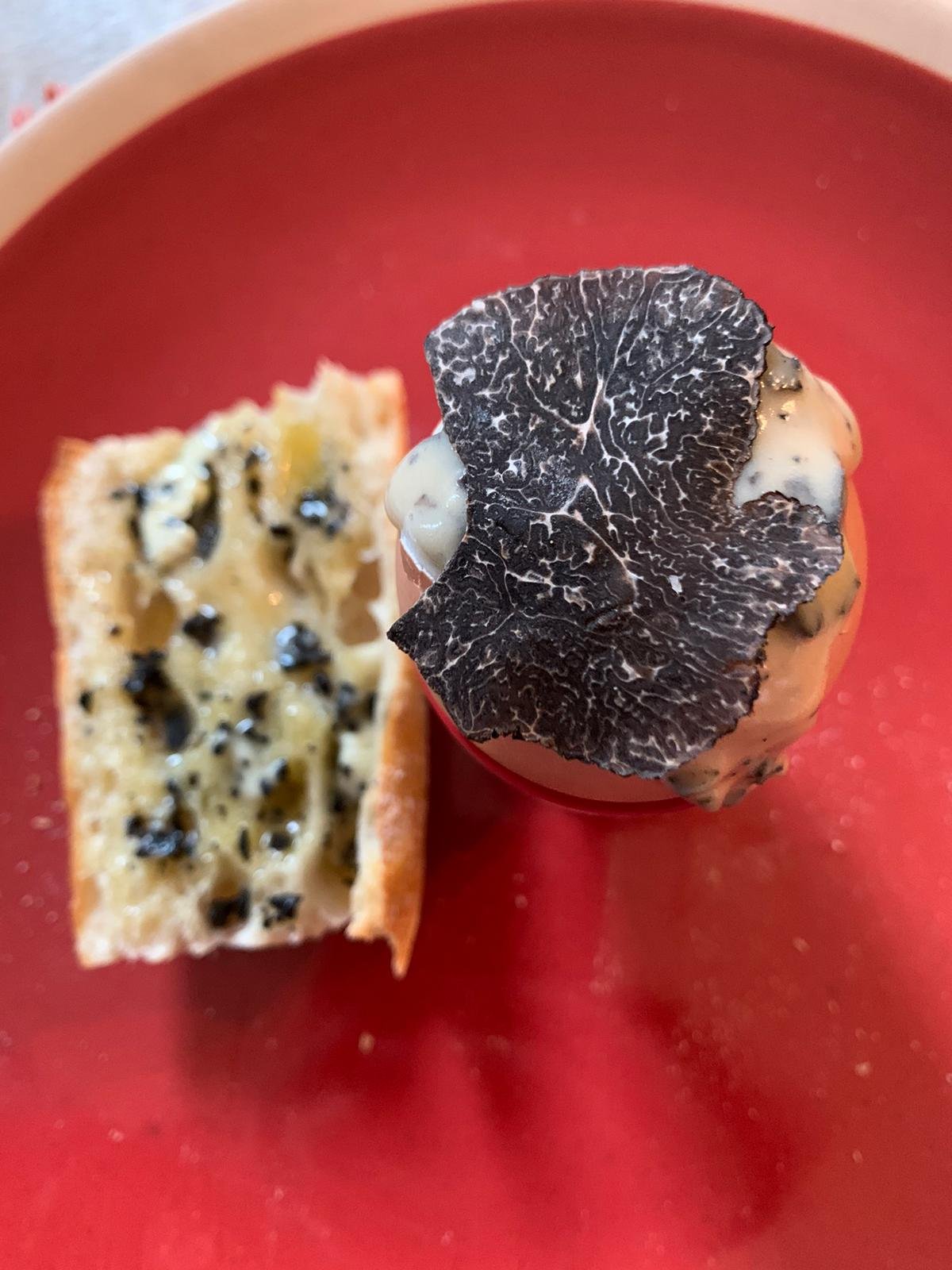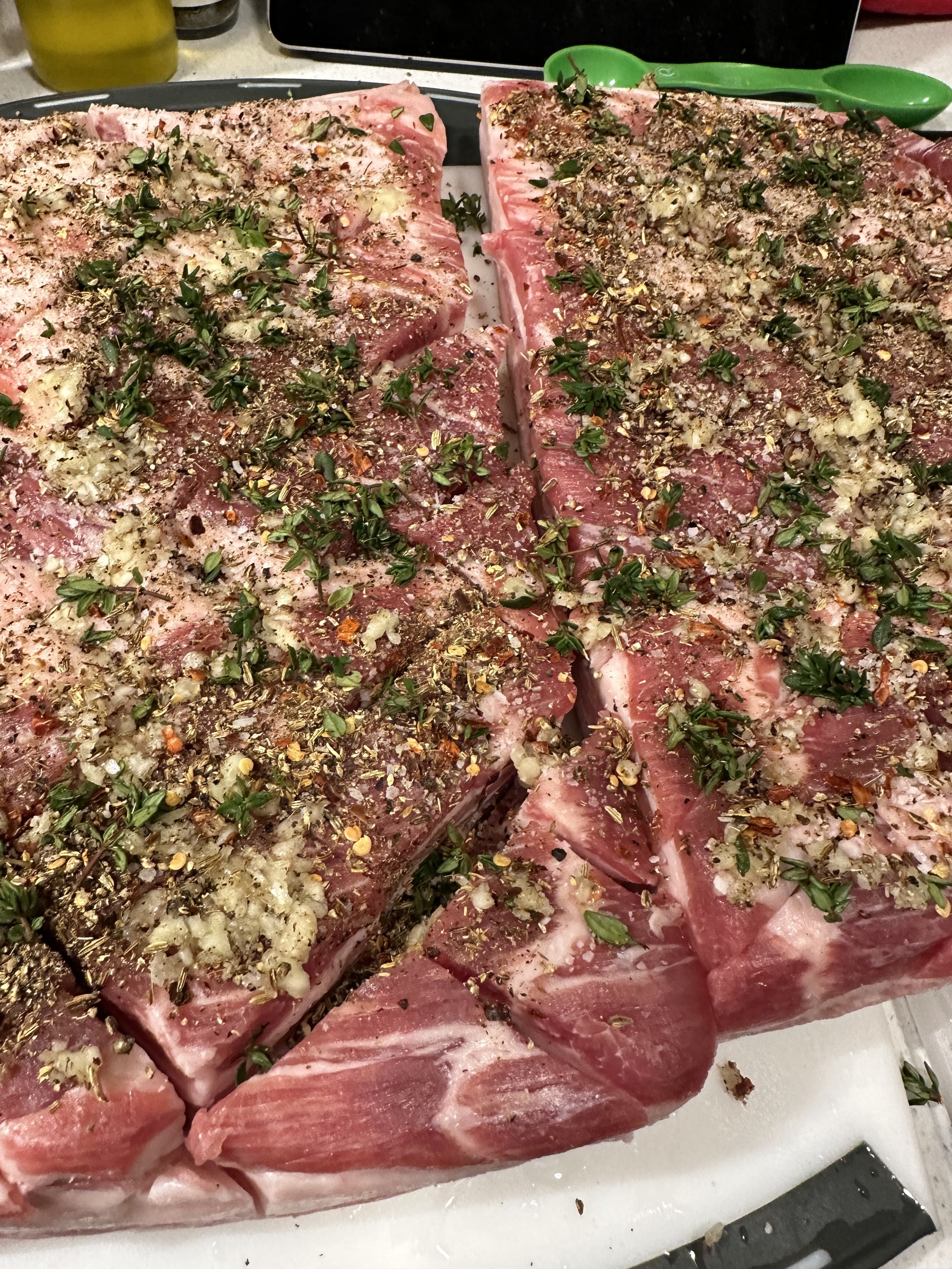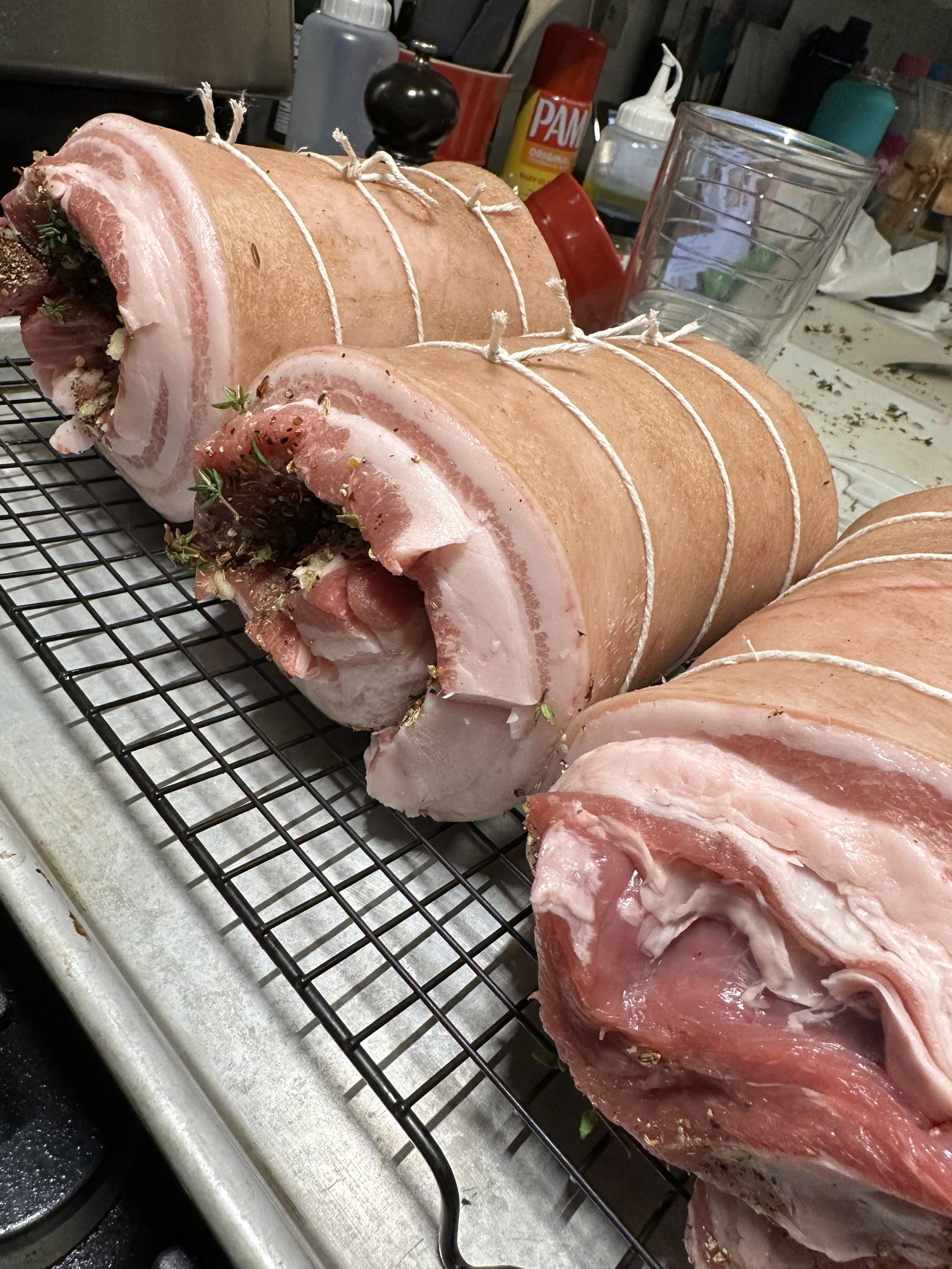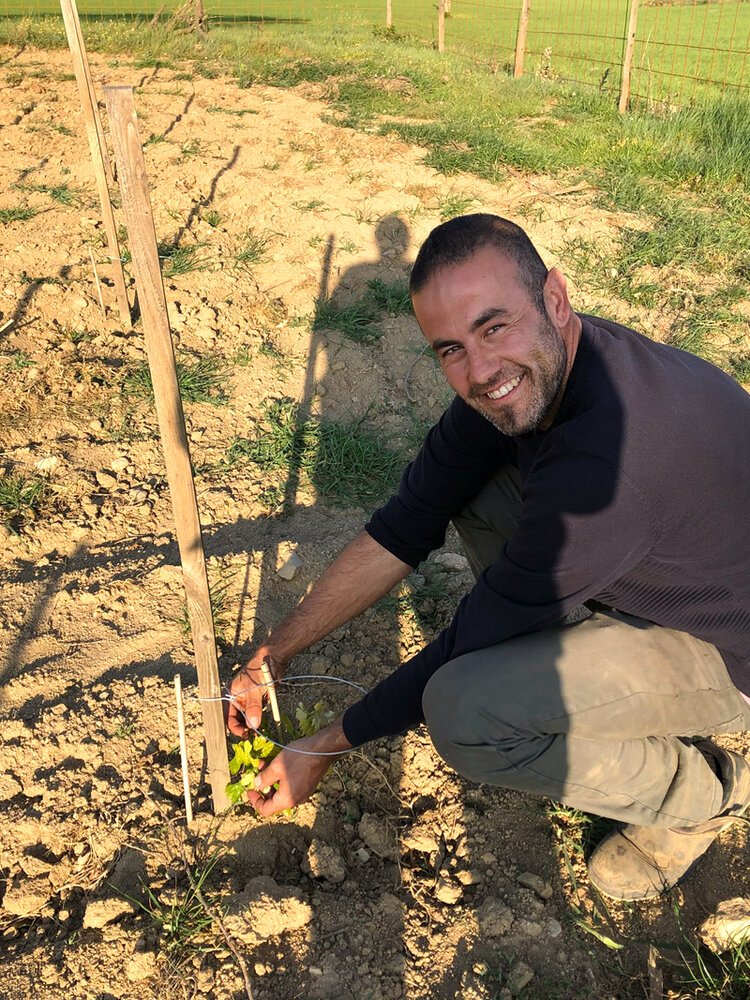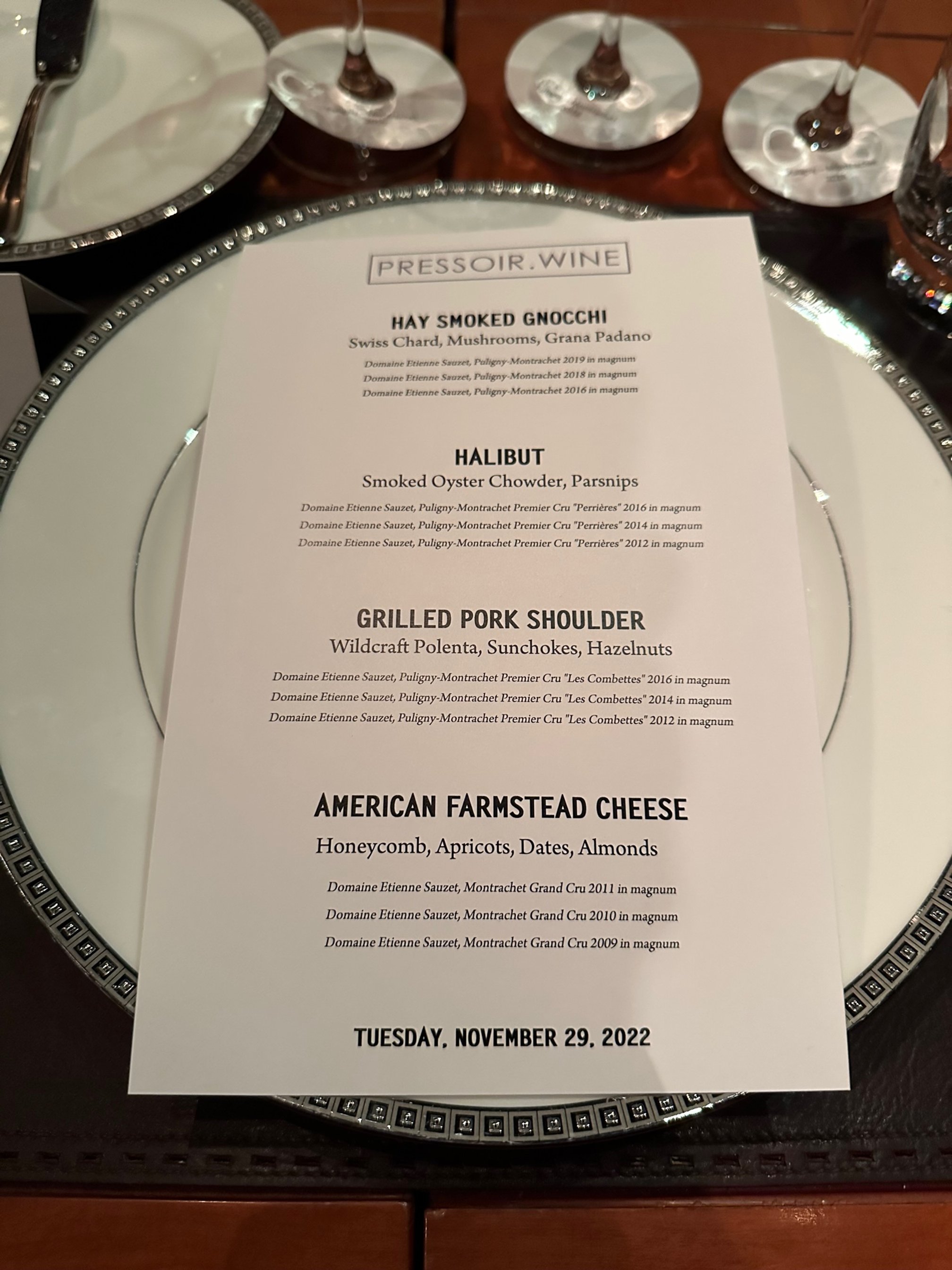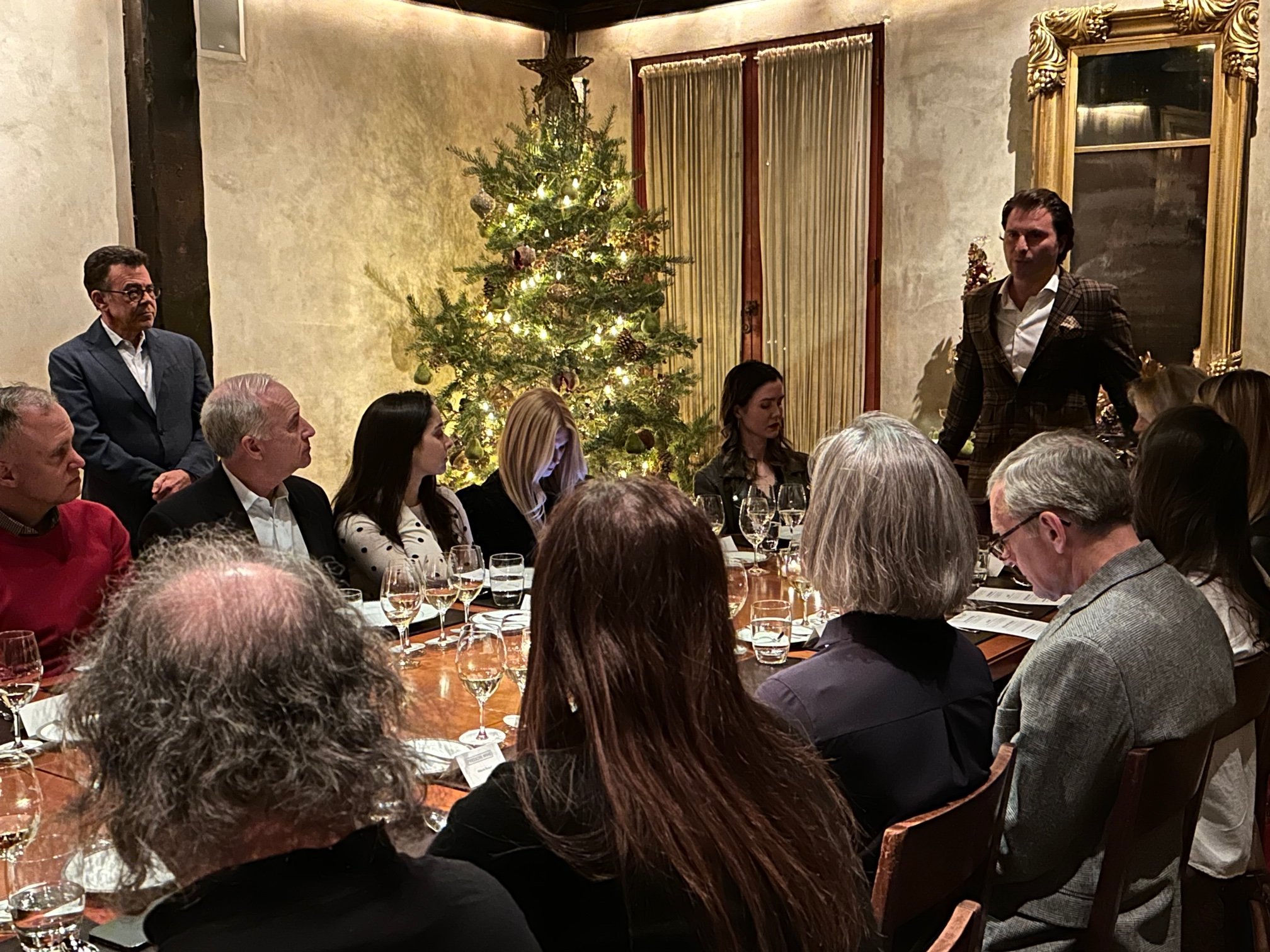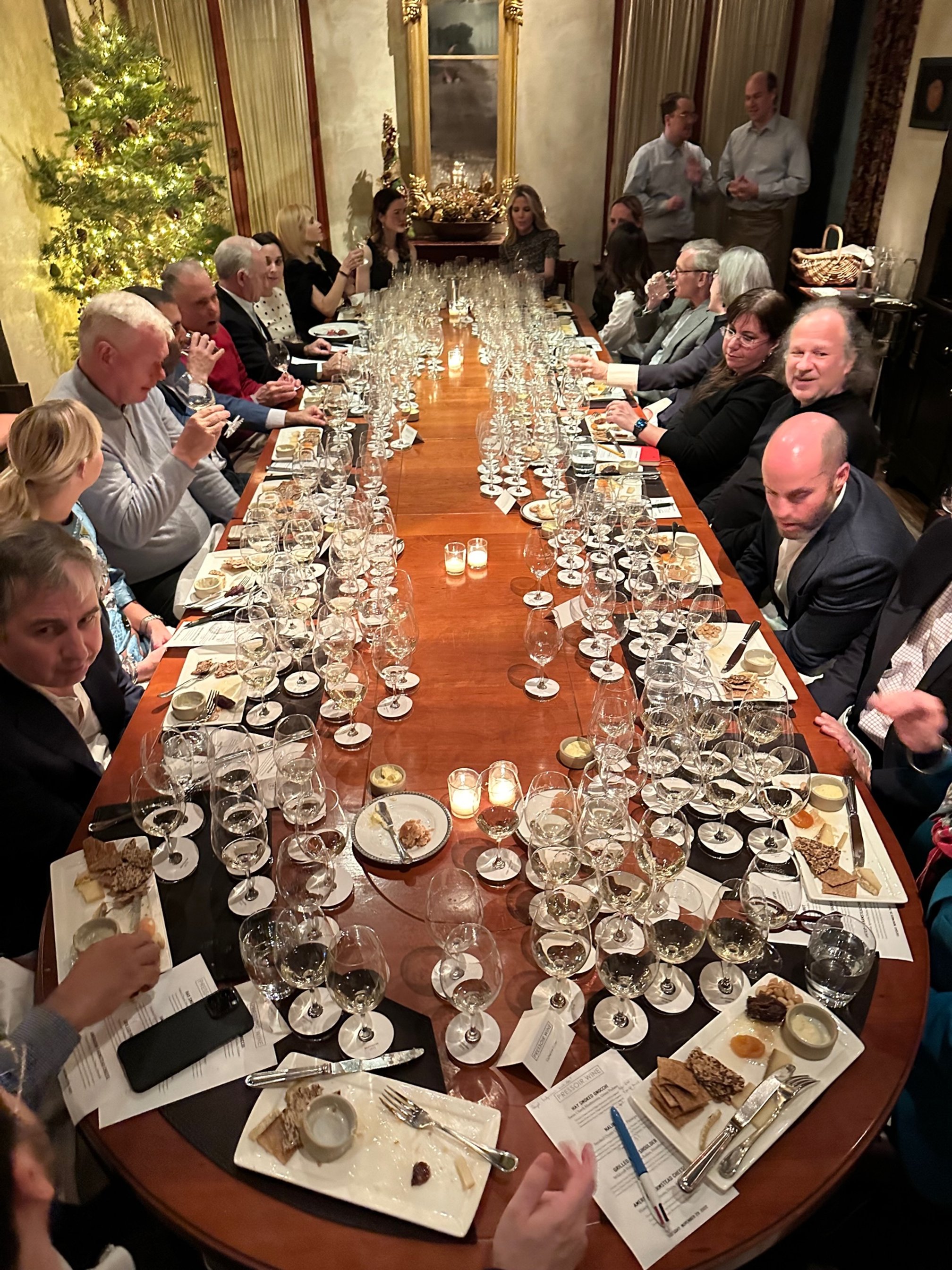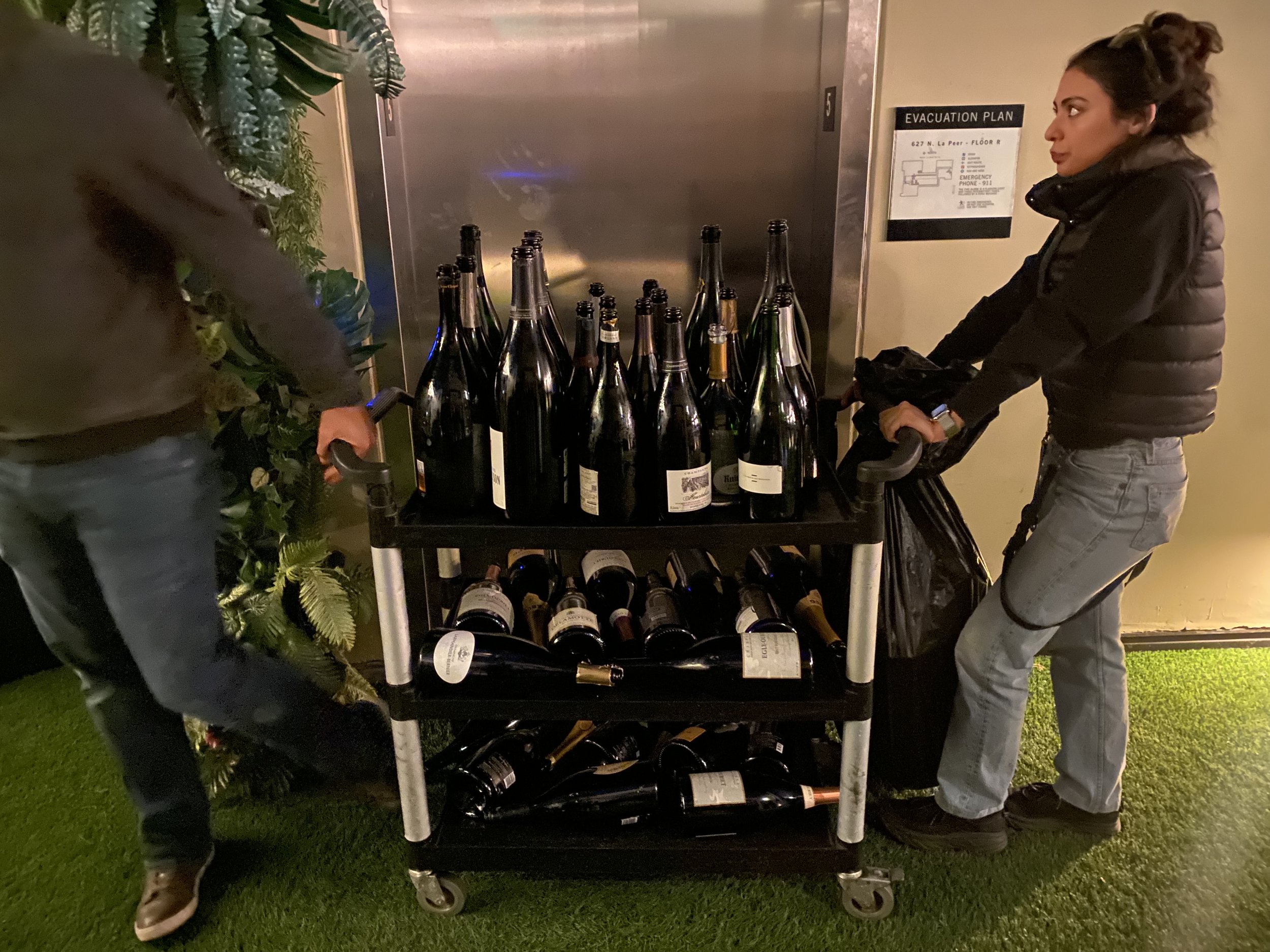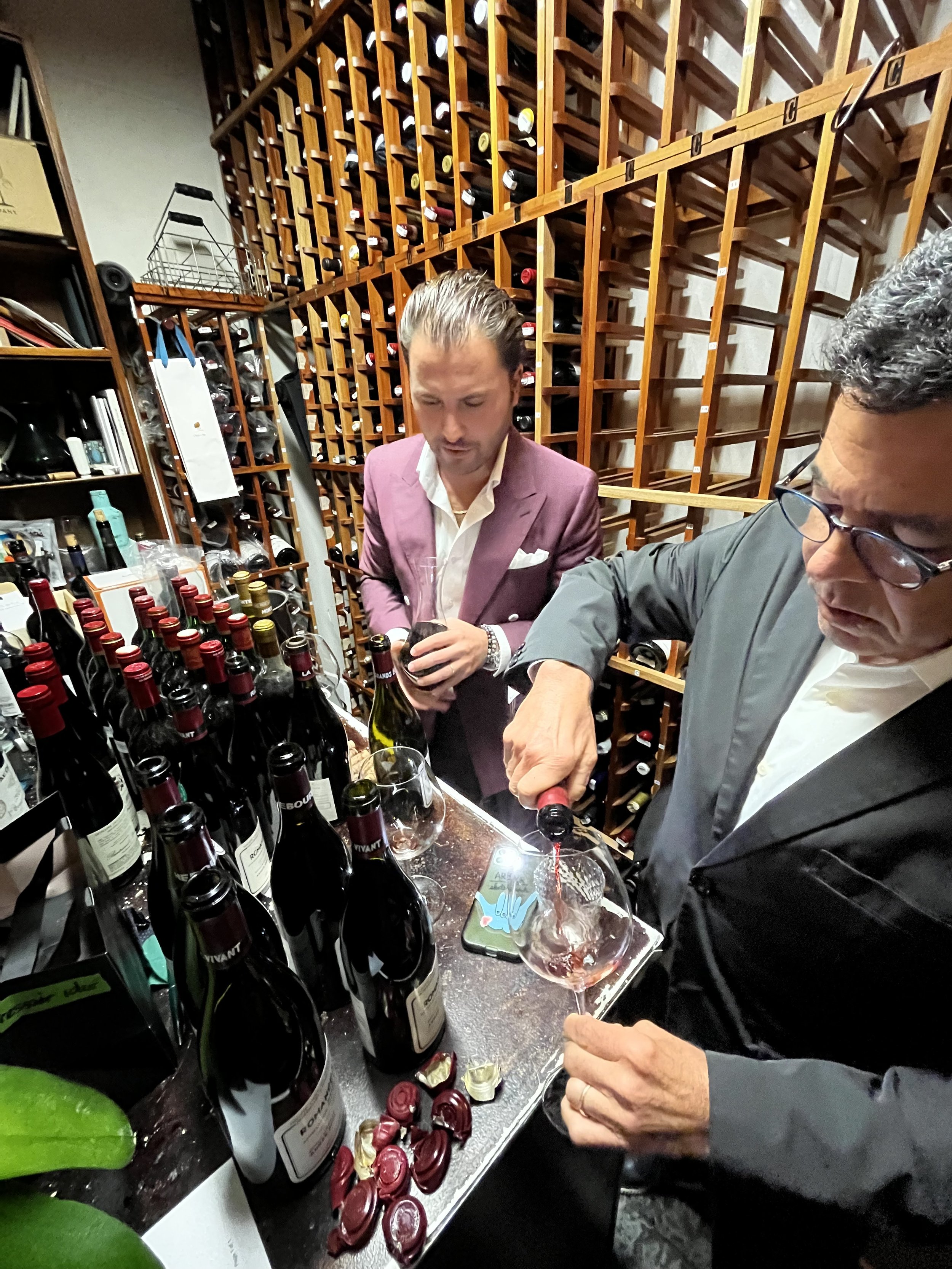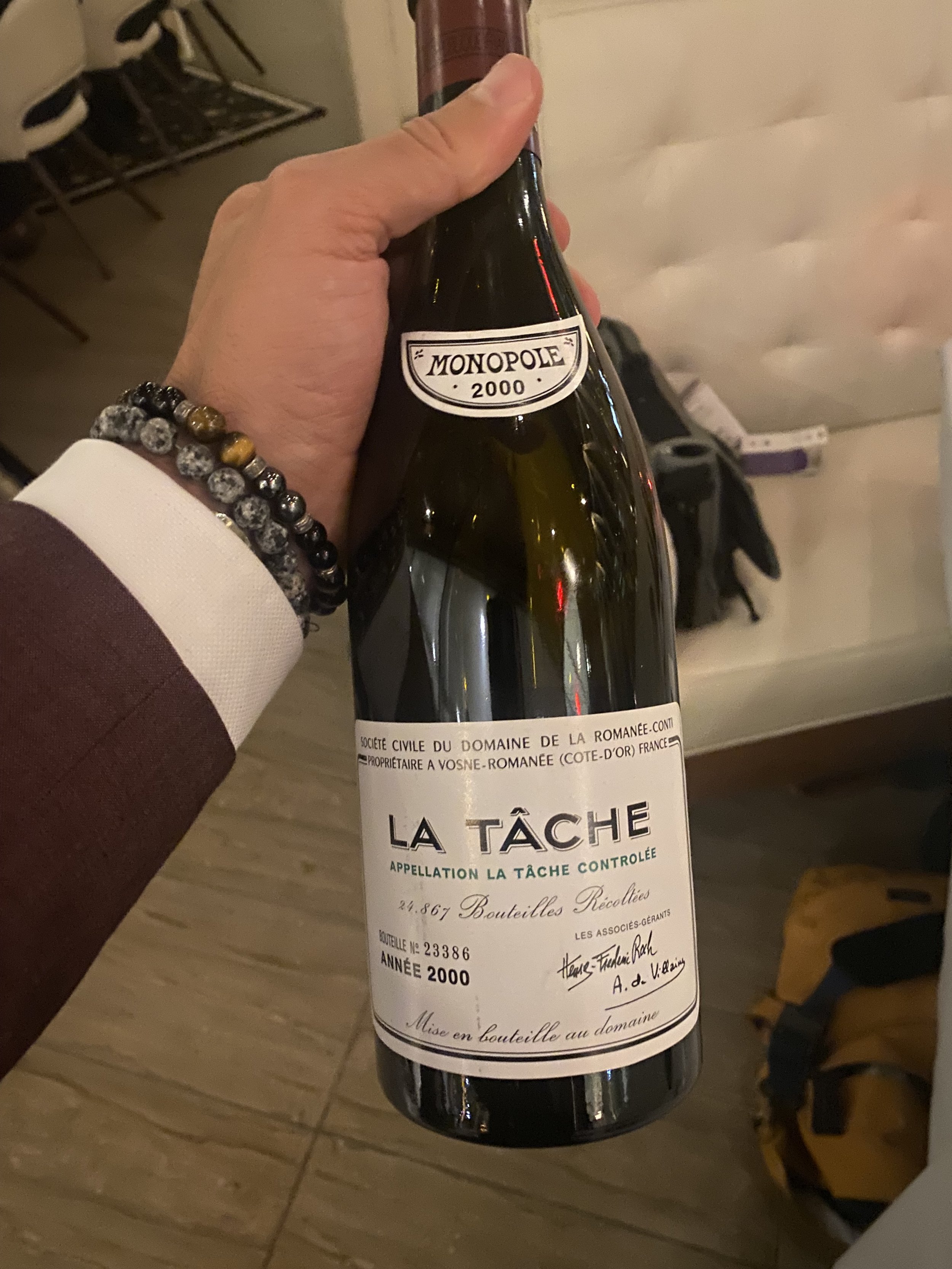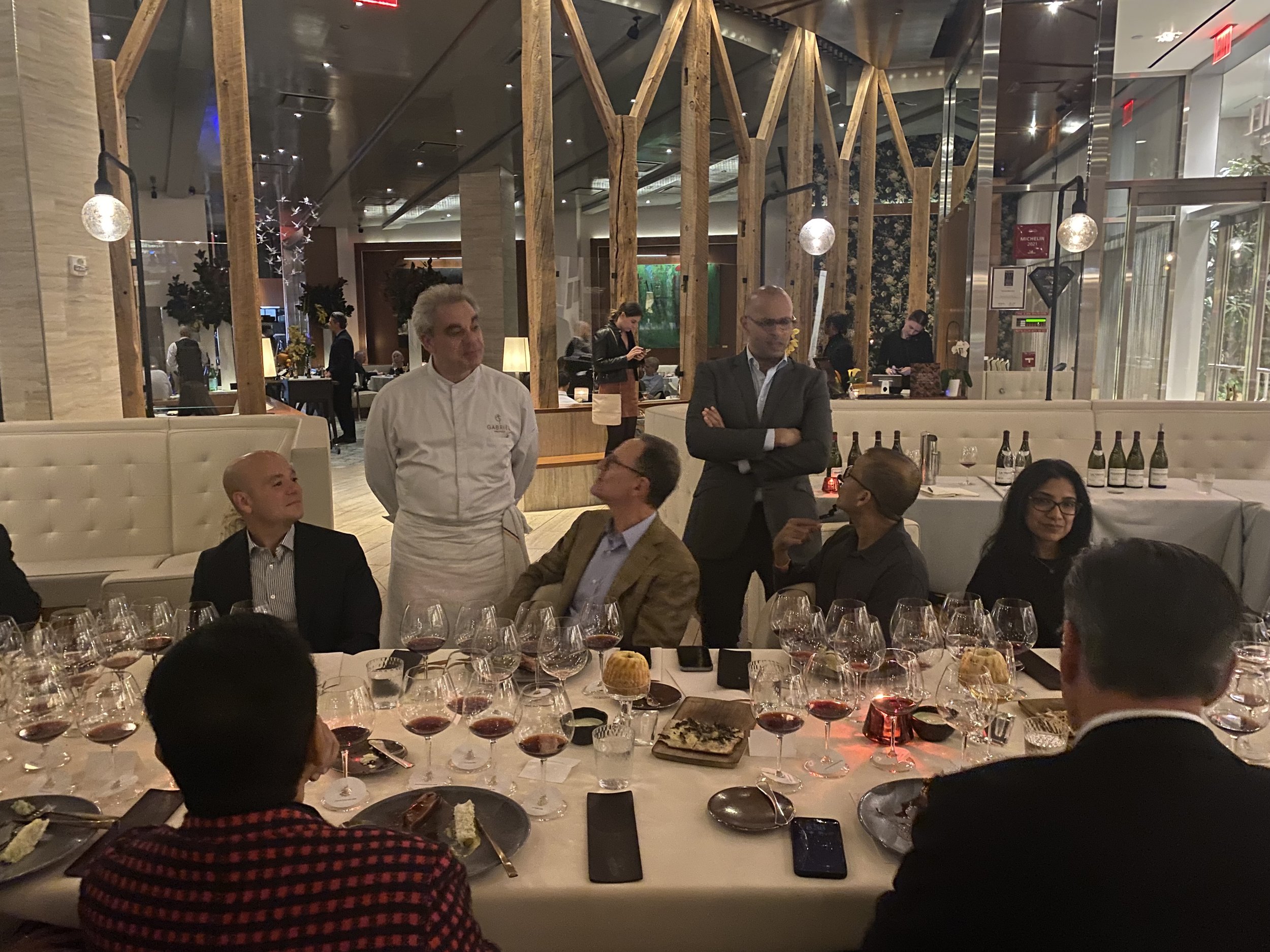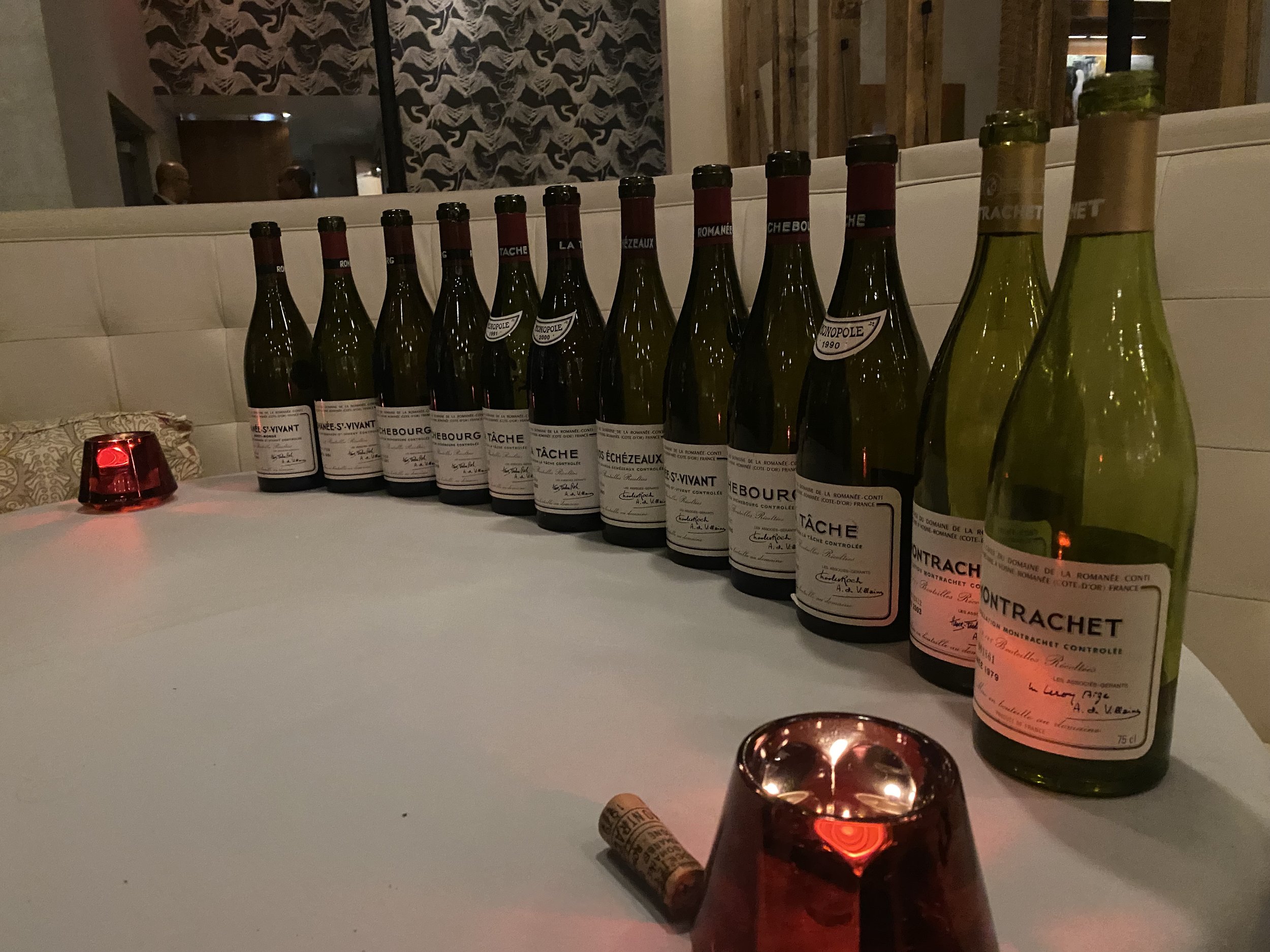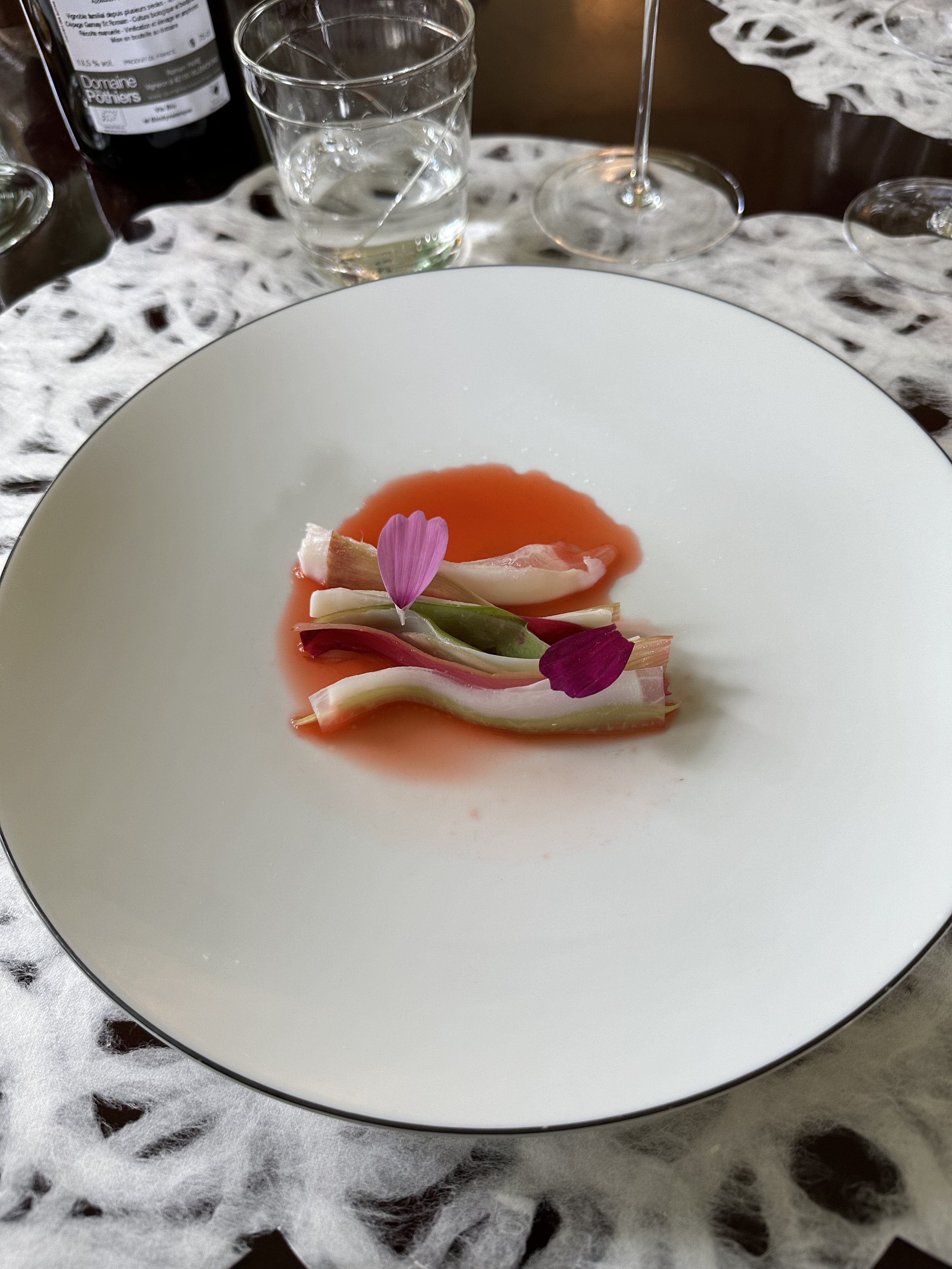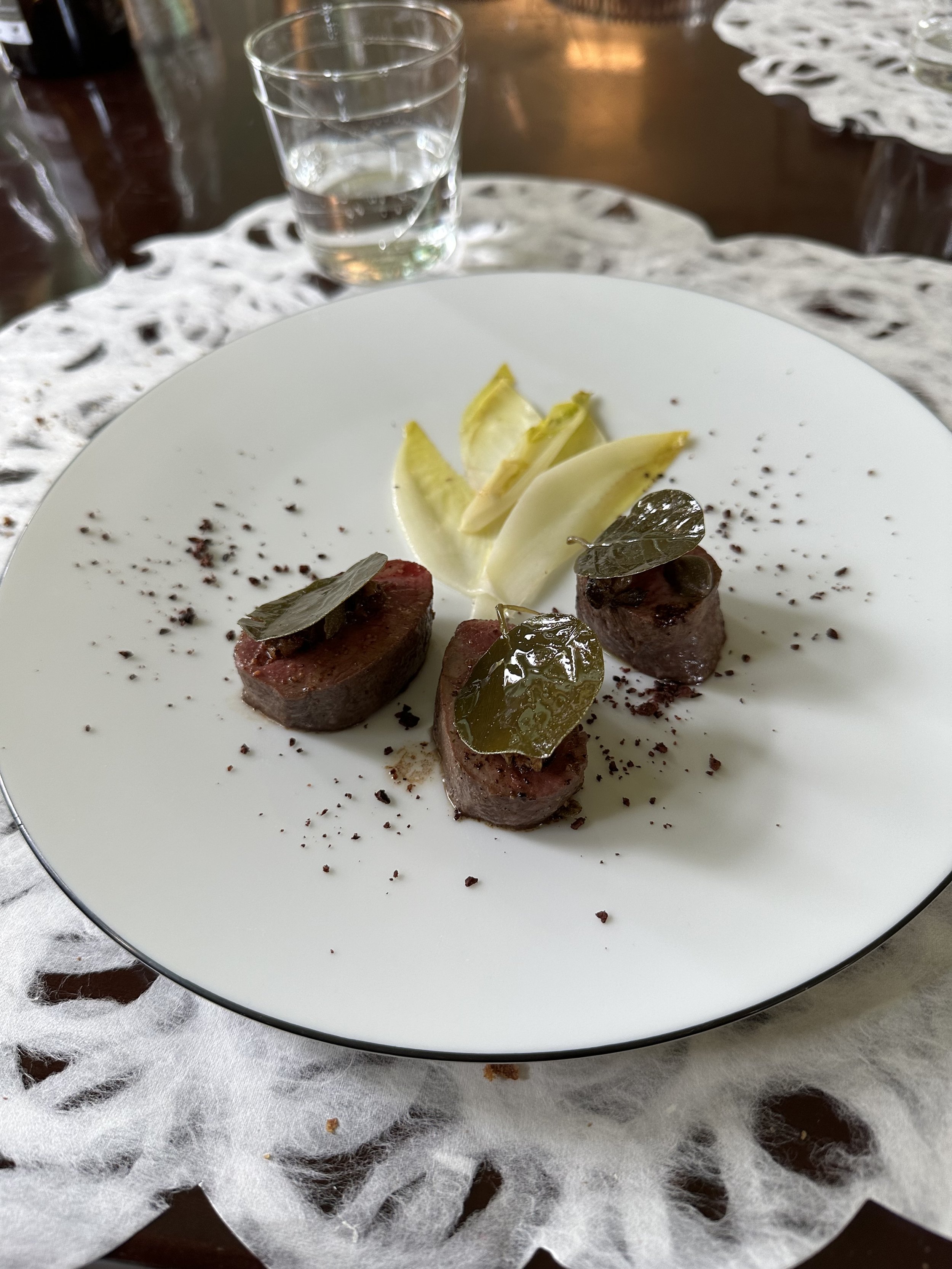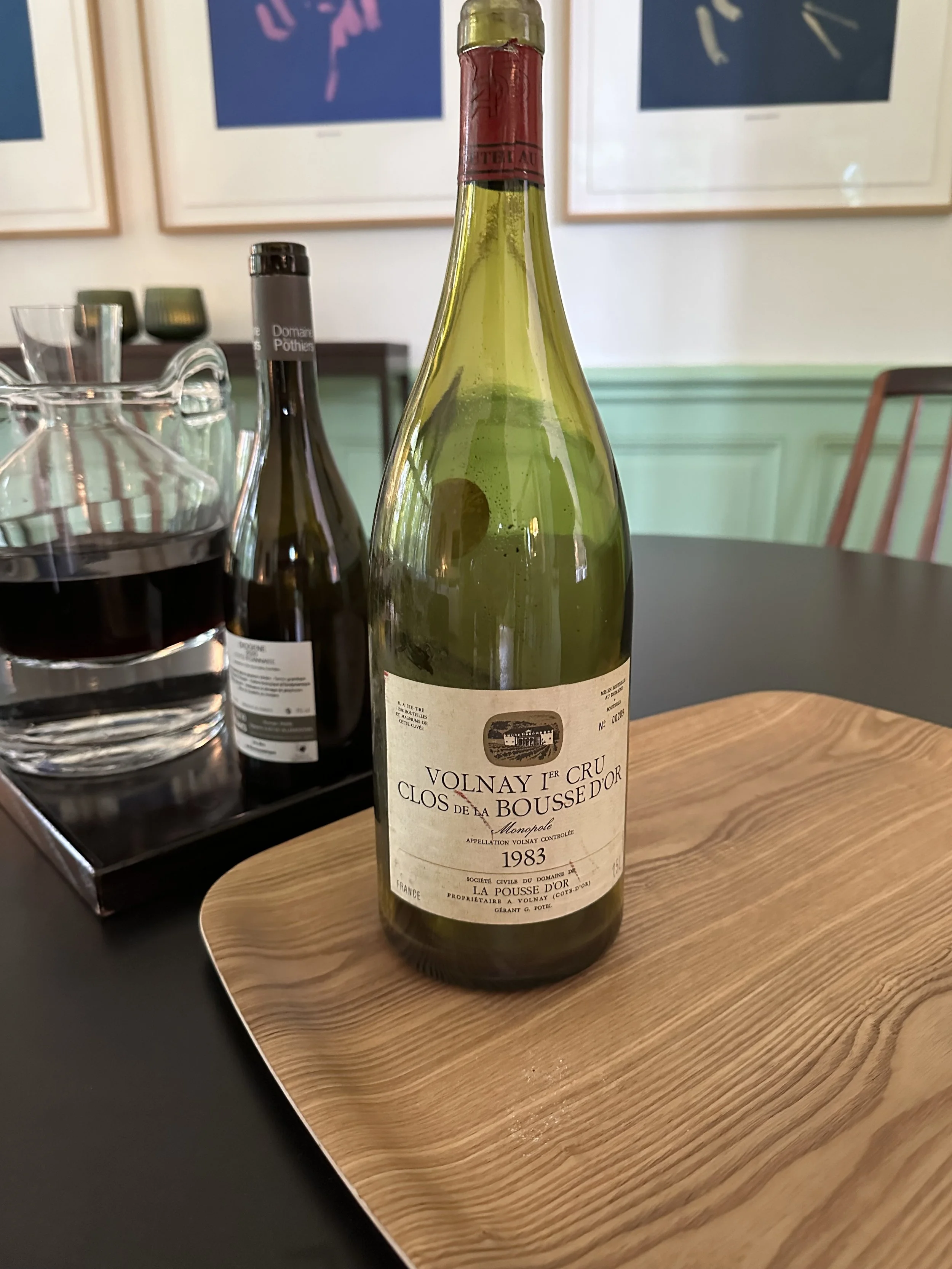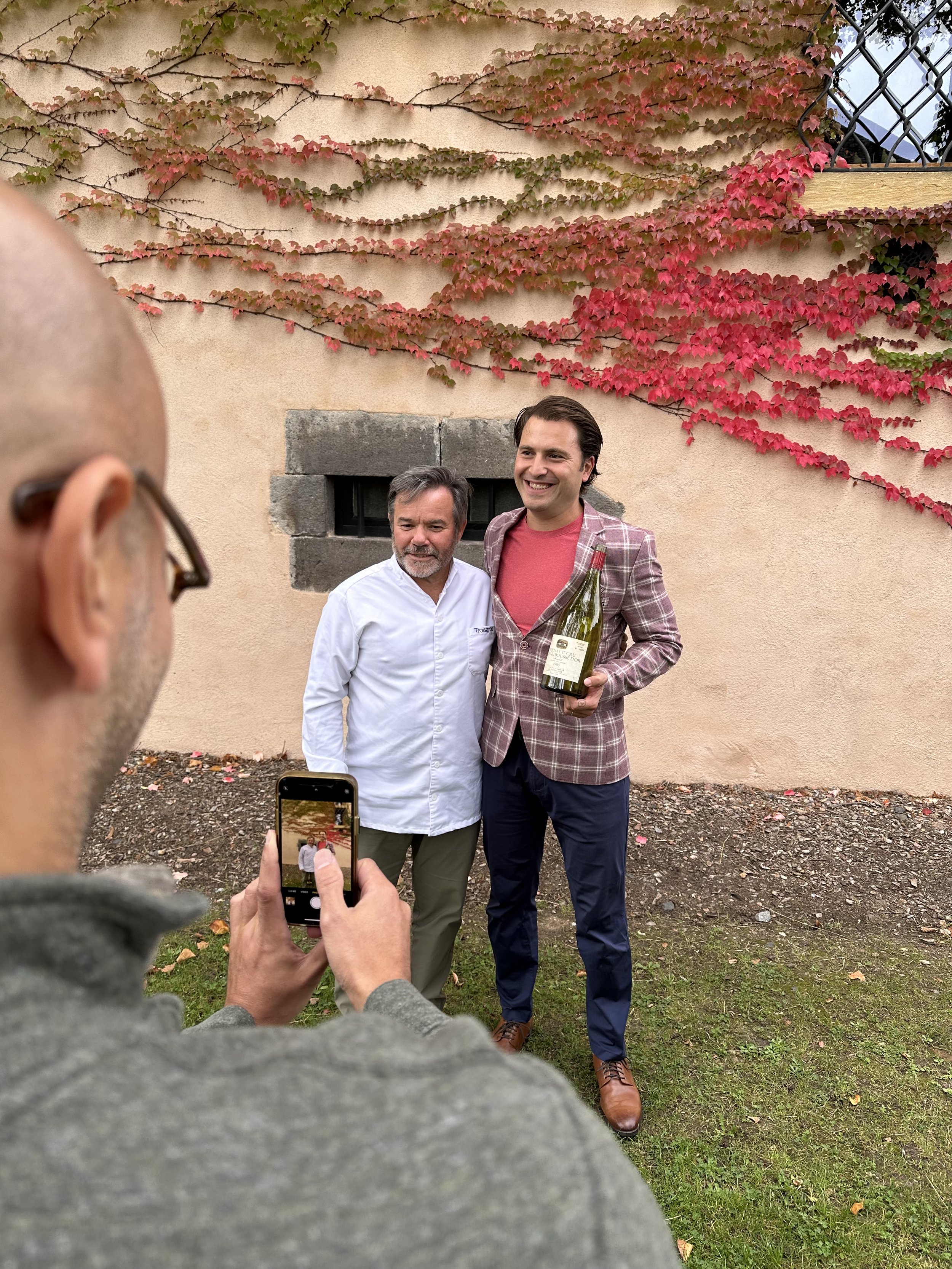The Press
We created The Press to house original content, as well as pertinent, interesting media from our friends and partners, exclusively for Pressoir Club Members.
Categories
What's Pressoir Drinking?
January 27, 2023
by Justine Puaud
2013 in burgundy
This week was clearly epic. I had the chance to follow Daniel, Raj, Max and 4 sommeliers on our Sommelier Scholarship trip on fantastic visits in the Côte de Beaune and Côte de Nuits. We were really fortunate to taste the 2021 vintage. It was maybe the only time I would be able to taste 2021… but my article this week is focusing on a different vintage! I think if we have to sum up what we tasted over the last 4 days we would say that the 2021s are incredible, delicate and fine wines. We were also all shocked how the 2013 has evolved and in such a good way. Every time we talked about vintages during the tastings, the winemakers and our team agreed on how well the 2013 wines are drinking now.
2013 was not an easy vintage but it is one of the great ones now because it surprises everyone and the winemakers are really happy about it.
Here is a quick overview of the 2013 vintage in Côte d’Or - marked by a difficult spring, 2013 was characterized by a production volume well below the average (approximately 20% less). The flowering was affected by rains and cool weather. Despite a pretty hot summer which favored good ripeness, the harvest only started at the end of September and ended, in some vineyards, in mid-October. These are the latest harvests in a quarter of a century. Nevertheless, these remain historically traditional dates for Burgundy.
Our first surprise was at Domaine Jacques Frédéric Mugnier when Fred Mugnier ended his 2021 tasting with a blind tasting… It is always difficult to say your thoughts to the winemakers. You don’t want to say Chambolle-Musigny Village if Fred just opened Les Amoureuses. For this one we all gave wrong answers, Echezeaux, Bonne-Mares … it was actually a Chambolle-Musigny 1er Cru Les Fuées 2013. Great concentration and good structure with florals, spices and dark cherries. .
Still in Chambolle, we went to see Charles Van Canneyt of Domaine Hudelot-Noellat. We did a vertical Les Suchots from 2021 to 1996 and we ended with Richebourg Grand Cru 2013. Definitely a cooler, red fruited vintage. The Richebourg was lighter, silky with a lot of elegance.
I will finish with THE Meursault Les Perrières of Domaine Jean-Marc Roulot 2013. Unbelievably focused nose displaying concentrated ripe yellow fruit. On the palate, it was incredibly rich yet pure. A big scale wine with a very good balance.
Pressoir.wine Session - 2012 Vintage Recap
Session Recap
By Edouard
1/20/23
Edouard Bourgeois
January 17, 2023
“What do you smell?” or “what food is best with this wine?” are questions I have been asked many times as a sommelier. But the one that might be even more common is “when is the best time to drink this bottle?” That last question, just like the other two, is never easy to answer. Although there is no doubt that some wines are meant for aging and others are deliberately made in a way that suggests early drinking, it remains a matter of personal taste. When it comes to Champagne for example, I like to feel effervescence and a vintage Champagne from the 60’s or even the 70’s is typically not my go-to. I know plenty of people who love these old Champagnes however…
Anyway, I thought that trying to understand how time affects a bottle of wine would be an interesting topic to discuss at a Pressoir Session. So I selected six wines with a decade of age, all from the 2012 vintage and from various regions of France, to see how a similar bottle age affects each wine differently, depending on the grape variety, the region and the winemaking style. And the goal was ultimately to determine which one showed best which turned out to be an engaged and polarized response from the attendees.
2012 was not an easy vintage for most French wine regions.
The damp summer that affected Burgundy gave mildew an ideal terrain to develop, forcing vignerons to drastically sort rotten grapes, resulting in low volumes at harvest. The quality can be very high in some places however, with soft tannins in red and concentrated whites. Champagne fared better and 2012 is recognized as an exceptional vintage with very healthy grapes and it is not surprising that most Champagne houses decided to declare the vintage for their prestige cuvée. The Rhône did good too and the particularity of the year was lower alcohol levels and quite surprisingly lower acidity levels too with some rigidity to Condrieu.
Here is a recap of the wines:
Champagne Pierre Paillard, Les Maillerettes Bouzy Grand Cru 2012
Pierre Paillard owns 11 Ha in Bouzy. Pinot noir 70%, Chardonnay 30%, 25 plots, average 30 years in age
Les Maillerettes (36Ares|0,9 Acre plot) is a single vineyard, single variety (Pinot Noir) and single vintage champagne crafted every year since 2007 and farmed sustainably. It was planted in 1970.
The wines are fermented in oak and aged sur lies for 11 months before bottling. Les Maillerettes then benefits from extended aging“ sur lie”: 5 years in the 19th century cellars.
Dosage: 2 grams per liter (Extra-Brut) Soil: pure chalk with only 50 centimeters (20in) of clay topsoil.
The wine was incredible and maybe my favorite. Champagne has a long history of aging its wines for an extended period of time.
Domaine Moreau Naudet, Chablis 1er Cru Vaillons 2012
Moreau-Naudet's holdings in Vaillons are around 1.7 hectares of 35-50 year old vines.
Fermentation is always with indigenous yeast, followed by a long maceration on lees (3 months). The wine is then aged for an average of 18 months (varies according to the vintage) on lees in a combination of stainless steel and 600-liter French oak barrels, of which only 20% is new.
Moreau-Naudet's holdings in Vaillons are around 1.7 hectares from Roncière, Séchet (75 year old vines) and Epinottes. In the new winery, the barrel room has a thermal floor that helps kick off fermentations.
The Chablis showed a lot of richness that made me a think of the presence of botrytis perhaps. I was expecting a crisper wine and if I knew how the wines showed, I would have served it after the Mâcon rather than before.
Domaine Olivier Merlin, Macon La Roche Vineuse Les Cras 2012
2.5 hour by car from Chablis, Macon produces 45 million bottles on average each year and many of these bottles can be forgetful and not very impressive.
Olivier Merlin however, is an old-school winemaker who prides himself on crafting non-manipulated wines with low yields in the Mâconnais and Olivier makes serious, long-lived, and delicious wines. Since starting his domaine in 1987 he has worked tirelessly to promote the wines of the region and now, as trends have come and gone, Olivier can be considered one of the region’s benchmark producers.
The majority of the wine is fermented in stainless steel tanks with around 10% going into older Burgundian barrels. The wine goes through malolactic fermentation and is bottled after 15 months of aging without being fined.
Superb bottle that should really help people realize the potential of this overlooked part of Burgundy.
Domaine Matrot, Meursault 1er Cru Les Charmes 2012
The domaine exists since the early 20th century. It went through farming changes to finally embrace organic viticulture along with ploughing, rigorous pruning and debudding in the spring to help control the yields. If necessary, a green harvest is carried out before veraison. The sanitary state, yields, and maturity are carefully observed.
Long and uneventful fermentations for 8-10 weeks are employed, and the quality of the lees is carefully monitored since they accompany the wine during the maturing process.
Bâtonnage (stirring of the lees) is done according to each vintage.
Chaptalization is avoided whenever possible and the alcohol content is never rectified by more than half a degree in order to maintain the natural balance of the grapes. It is important to recognize and respect variability with each vintage, for example, knowing that one year a grape can be ripe at 12 degrees of potential alcohol, and the following year reach ripeness at 14 degrees.
The wines are matured for 11-12 months in oak barrels with a capacity of 228 liters. One- to five-year-old barrels are used for the white wines and 10-20% new barrels for the reds.
When it comes to the climat Charmes, you enter the very best of Meursault. Matrot owns four plots within Charmes, of which 70% are located in Charmes-Dessus. Les Charmes is a well-balanced wine with both the ampleness of the Charmes-Dessous and the minerality and elegance of the Charmes-Dessus.
We all agreed on the classic profile of this deliciously hazelnutty and buttery Meursault. Quite opulent, I would drink this wine now although a few more years wouldn’t hurt.
Domaine Yves Cuilleron, Condrieu Les Chaillets 2012
The Cuilleron family domaine, located in the hamlet of Verlieu (part of the town of Chavanay), was founded several generations ago (1920). Yves Cuilleron’s grandfather was the first to bottle wine for commercial purposes in 1947. Antoine Cuilleron, the uncle and immediate predecessor of Yves, assumed control of the domaine in 1960 and significantly increased the percentage of wine bottled at the estate and extended the scope of the domaine. Yves assumed full ownership and direction of the domaine in 1987 and, since that time, has built an entirely new facility while at the same time acquiring additional vineyard property. The domaine is now (as of 2012) significantly larger in scope with 52 hectares of vineyards that cover multiple appellations, including principally, Condrieu, Saint Joseph Rouge and Blanc, Cote Rotie, Saint Péray and a series of Vin de Pays from the Collines Rhodaniennes.
A large majority of the vineyards are set on terraces which makes most mechanization difficult, if not impossible. Thus, much of the vineyard work continues to be done by hand. To control yields, Cuilleron does extensive debudding and, when necessary, practices a “green harvest”.
In the cave, the grapes (harvested manually) are fermented using indigenous yeasts. The fermentations of the appellation controlée white wines are done in small barrel of one to four years age; malolactic fermentations are done in barrel as well and the elevage continues for nine months before the wines are bottled.
Condrieu Les Chaillets: This cuvée is sourced from the best exposed and the oldest Viognier vines of the domaine (south-southeast exposure, planted on terraces in the commune of Chavanay). Barrel-fermented and barrel-aged with regular batonnage during the nine-month elevage. The whites are lightly filtered before bottling.
Condrieu is a very unique wine and Viognier may find its most exuberant expression in this appellation. Pineapple, pear and mango exploded from the glass. Low acidity.
Domaine Bruno Clair, Gevrey Chambertin 1er Cru Les Cazetiers 2012
The classic domaine farms around 24 hectares in Marsannay la Cote, at the very northern end of the Côte de Nuits.
The vineyard of Cazetiers is 0.9 ha (2.2 ac) and the domaine’s plot was planted in 1958, 1972, 1996. Direct neighbor of the famous Clos St. Jacques, Cazetiers shares its poor marl soil and limestone deposits.
“For a while, people mentioned a derivation of the word castel, in reference to the position of the climat above the castle of Gevrey-Chambertin. According to Françoise Dumas, the more plausible explanation is that Cazetiers was derived from cassis, which would indicate the presence of wild cassis or red currant bushes.”
Bruno Clair points out an interesting difference between Les Cazetiers and Clos Saint Jacques: In his cellar Les Cazetiers always has a higher pH (lower acidity). This translates into the flavors of the wines, with Cazetiers always feeling like blacker fruit, and Clos-Saint-Jacques like redder fruit.
Because of its location, it lies exclusively on stark white, completely decomposed marl, or terres blanches. Here, it has a very hard, cement-like quality, causing the vines to struggle. The topsoil is only about 10 cm deep and consists of up to 45% gravel and up to 10% cobbles. It is followed by a thick layer of laves, followed by a second layer of terres blanches soil before reaching the limestone bedrock.
Despite the fact that Les Cazetiers is more sheltered from the wind from the Combe de Lavaut than Clos Saint Jacques, Bruno says it systematically ripens one week later.
Of all the 2012’s we tasted, this Gevrey seemed the youngest with still grippy tannins and a certain austerity. The fruit was dark and concentrated in the glass. Notes of black pepper and cassis.
As a blind wine, we poured another Gevrey Cazetiers, from the Bruno Clair once again but this time from 2002. A good vintage. Summer was not especially hot, though it was reasonably dry. Sugar levels were boosted in September but some grapes were adversely affected by scattered rains then. Sugar levels were quite respectable in the end and most wines showed their charm at an early stage.
The wine clearly showed more age but probably not ten more years than the 2012. The austerity of the 2012 was well polished here although a hint of volatile acidity could be felt. It didn’t distract too much from the experience as the richness of fruit was in full bloom.
What's Pressoir Cooking?
Truffle season
Eggs and truffle purée by Chef Jean-Michel Belin of Le Beauvallon Hotel in Provence
by Justine Puaud
January 18, 2023
We are in the middle of the truffle season. The famous truffle market is in Richerenches in France and is open from November to March every year. If you plan to visit the Provence region around this time of year, you have to make a stop there. It is not like a traditional farmer market. You enter a quiet street where there are a dozen mini vans and people will be selling truffles from the back of their cars…
The tuber melanosporum, also called black truffle, is quite strong on the palate. I tried many recipes with truffles and I think overall the simplest recipes are the best (omelette with truffle, pasta with truffle, French coquilles Saint-Jacques carpaccio) But, I have to say, the soft boiled egg with a truffle purée is among my favorites. The mix between truffle, béchamel sauce and madeira makes this recipe just delicious and really enhances the truffle.
Ingredients
12 fresh eggs
120g fresh truffle
30g béchamel sauce (if you don’t know how to make a béchamel, check out this recipe)
40 cl heavy cream
120g of butter
25 cl of madeira
25cl of truffle juice (buy a can of truffle juice from Plantin)
6 slices of bread (ie traditional baguette)
salt and pepper
Instructions
Sauce
Put the eggs and truffles in an airtight container in the refrigerator the night before.
Put the eggs in the blender to obtain a very fine purée or cut the truffle into very small pieces.
Make a béchamel.
Then, in the saucepan, reduce the Madeira and truffle juice to dryness, add the cream and the béchamel. Leave to cook for a few minutes, stirring.
Add the truffle purée and the béchamel to the Madeira and truffle juice and leave over low heat for 3 minutes.
Cook the eggs for 3 minutes in salted boiling water. Remove the egg from the shell, then using a teaspoon, remove the little white that is not cooked.
In a frying pan, brown the slices of bread with a little butter, then cut them into "mouillettes" and keep them warm.
It's almost ready to eat. Fill the egg cavity with the truffle purée, dip the bread in the egg with the sauce and enjoy.
Pressoir.wine Dinner - Grands Crus of Joseph Drouhin Recap
Pressoir Dinner Drouhin Recap
By Edouard
1/13/23
Edouard Bourgeois
January 13, 2023
Joseph Drouhin is one of the most recognizable producers in Burgundy in terms of the size of their operation but also when it comes to producing fine wines from some of the best terroirs. From Chablis down to the Côte Chalonnaise, Drouhin has been producing a myriad of ninety different appellations for four generations. The house was founded in 1880 and has been acquiring vineyards in the most coveted areas while their negociant activity also allows them to buy grapes from long term contractors.
Joseph Drouhin is also synonymous with clean farming practices, as the domaine became organic in 1990 and biodynamic a few years later.
Last night’s dinner at Le Pavillon was sensational with a focus on four iconic Grands Crus from Drouhin. We kicked things off with a flight of Grands Echezeaux followed by Clos de Beze and Griotte Chambertin and crowned the event with the majestic Montrachet from Marquis de Laguiche. My recap below:
GRANDS-ECHEZEAUX 2013/2010/2005
Out of the nine ha of this large Grand Cru climat, Drouhin owns almost half an hectare. The geographic situation of Grands Echezeaux is quite exceptional and that didn’t go unnoticed by the monks of Citeaux who already owned the nearby Clos de Vougeot. Although they didn’t get to put their hands on vines in Musigny, when they acquire Grands Echezeaux, the motivation was to make a wine as fine as its prestigious neighbors. The three vintages we tasted showed really well. Starting with the complicated 2013, a vintage that brought cold, rainy weather with an episode of hail, 2013 forced vignerons to be cautious to sort out rotten grapes. Here, I thought the 2013 showed really well and didn’t lack maturity as I sometimes find in 2013. Although I could detect a touch of dried grapes on the nose. 2010 delivered a cleaner, delicious fruit quality with the concentration often associated with the vintage. Great bottle with necessary acidity to lift the wine. Drouhin used a generous portion of whole clusters that year, good call! 2005 behaved as expected, a powerful, high alcohol wine that in my opinion need more time to develop secondary aromas. I could feel some “heat” in the finish.
CLOS DE BEZE 2013/2010/2005
It was really interesting to repeat the same flight of vintages from a very different site. Clos de Beze is one of the oldest clos in Burgundy. Although the walls are now gone, the Clos de Beze was a very important plot for the monks of the Abbey of Beze, who became owners in 630 AD, until they lost ownership in 1219. This exceptional vineyard, due east and on a mild incline, covers fifteen ha and Drouhin only owns a mere 0.13 ha of it. So tasting three vintages side by side is quite a treat!
That was a brilliant flight, starting with a really pretty 2013 that had a juicy fruit character. 2010 may have produced low yields, this was a stunning wine. I really am a fan of the vintage in general and this bottle had the ripe cherry and almondy aromatics I crave in a red Burgundy along with ultra elegant tannins. Bravo! Once again, 2005 felt a touch too alcoholic for my taste but finesse is indisputable.
GRIOTTE CHAMBERTIN 2002/2000/1990
Joseph Drouhin is among the nine lucky owners of Griotte Chambertin, this tiny gem of a Grand Cru nestled just below the Clos de Beze. Drouhin’s plot is about half an hectare, out of the total 2.5 hectares of Griotte. The dry summer of 2002 was saved by needed rainfalls at the end of August. The results were balanced wines that seem to have everything in good proportions, between alcohol, sweetness and acidity, while tightly packed in a fine tannic structure. The Griotte 2002 was superb with noticeable acidity that suggests a long life ahead. 2000 Griotte Drouhin has been a favorite of mine for a while. The wine is highly seductive and dare I say “Chambollesque”. The small red fruit profile is irresistible. Finally 1990 performed highly. We decanted the bottle right before serving it, not so much for oxygen but to get rid of the good amount of sediments in the bottle. The tertiary aromas were delicious and the wine still pristine with hints of confit oranges and a delicate body.
MONTRACHET MARQUIS DE LAGUICHE 2014/2012/2010
Sitting almost equally on both villages of Chassagne-Montrachet and Puligny-Montrachet, Montrachet is at the pinnacle of white Burgundy. Of the eighteen owners of this eight hectare grand cru climat, the Marquis de Laguiche family owns the largest plot, all in the Puligny-Montrachet side. Two hectares of glorious land in the Laguiche family since 1776. Joseph Drouhin started running the farming and making the wine from this plot in 1947 and continues to do so today. Along with Clos des Mouches or Griotte Chambertin, Montrachet Laguiche is an iconic wine at Drouhin.
2014 was powerful, a true Montrachet! The exuberance was matched by incredible minerality and a mind blowing length. Really impressive bottle. 2012 was another big hit. Pristine wine in a great spot. Some hints of coconut and again this powerful character with oily texture and mouthfeel. Delicious citrus jam quality. 2010 followed the same pattern. The harvest was a bit rushed by finnicky stormy weather conditions but the result is highly satisfying.
Finally, a special thank you to Eric Foster, our guest and Club Member, who generously shared his bottle of Montrachet Laguiche Drouhin from 1996. After having a few disappointing bottles from that tricky vintage, that bottle showed a healthy profile with no trace of oxidation. What a way to close the night!
What's Pressoir Cooking? Crispy Porchetta
by Max Goldberg Liu
Wednesday, January 11, 2023
by Max Goldberg Liu
January 11, 2023
Tasked with cooking the main course for a New Year’s Eve dinner party, I wanted to try something different than the typical prime rib or steaks that we usually spring for on special occasions. I’d always wanted to try making a porchetta, the savory rolled Italian pork roast that feeds a crowd - and then some. My go-to recipe source, Serious Eats, came through yet again with a dead-easy version of the dish that omits the often-dry pork shoulder component in favor of the pure succulence and fatty goodness of pork belly.
My local Whole Foods had slabs of rind-on pork belly that were around 12 inches wide, so I ended up making multiple porchettas. I deeply scored the meat-side and rubbed in a flavorful mixture of garlic, red pepper flakes, fresh thyme, ground fennel, and plenty of salt and pepper. Once rolled and tied, I rubbed the skin of each porchetta with a mixture of salt and baking powder which, Serious Eats tells us, lowers the PH of the skin and helps it get as crispy as possible, which definitely worked! After 24 hours in the fridge, the porchettas were ready to roast for 3 hours in a 275º oven, followed by around 25 minutes at 500º to put the final crisp on the skin.
This was seriously one of the best things I’ve ever cooked at home, and the ultra-crispy skin, super flavorful belly meat, and delectable fat made for an awesomely rich New Year’s Eve. We first paired it with a 2015 Barbaresco from Cantina di Glicine, whose acidity and tannin made for a great foil to the pork. A 2019 Côte-Rôtie from Clusel-Roch also paired quite well with it. And while ultimately we ended up hosting fewer people than expected at the dinner, it turns out that leftover porchetta also makes for great sandwiches!
I highly recommend giving this recipe a shot if you like crispy, fatty pork - I can’t overstate how easy it was to do.
All Belly Crispy Porchetta (from Serious eats)
Ingredients:
1 whole boneless, rind-on pork belly, about 12 to 15 pounds (5.4 to 6.8kg)
2 tablespoons whole black peppercorns
3 tablespoons whole fennel seeds
1 tablespoon crushed red pepper
3 tablespoons finely chopped rosemary, sage, or thyme leaves
12 cloves garlic, grated on a microplane grate
Kosher salt
2 teaspoons baking powder
Instructions:
Place pork belly skin-side down on a large cutting board. Using a sharp chef's knife, score flesh at an angle using strokes about 1-inch apart. Rotate knife 90 degrees and repeat to create a diamond pattern in the flesh.
Toast peppercorns and fennel seeds in a small skillet over medium-high heat until lightly browned and aromatic, about 2 minutes. Transfer to a mortar and pestle or spice grinder and grind until roughly crushed.
Season pork liberally with salt, then sprinkle with crushed pepper and fennel, red pepper, chopped herbs, and microplaned garlic. Use your hands to rub the mixture deeply into the cracks and crevices in the meat.
Roll belly into a tight log and push to top of cutting board, seam-side down. Cut 12 to 18 lengths of kitchen twine long enough to tie around the pork and lay them down in regular intervals along your cutting board, about 1-inch apart each. Lay rolled pork seam-side down on top of strings. Working from the outermost strings towards the center, tie up roast tightly. Combine 2 tablespoons kosher salt with 2 teaspoons baking powder. Rub mixture over entire surface of pork.
If roast is too large and unwieldy, carefully slice in half with a sharp chef's knife. Wrap tightly in plastic and refrigerate at least overnight and up to 3 days. If desired, porchetta can also be frozen at this point for future use (see notes).
Adjust an oven rack to the lower-middle position and preheat oven to 300°F (150°C). Place pork in a V-rack set in a large roasting pan, or if cooking both halves at the same time, on a wire rack set in a rimmed baking sheet. Place roasting pan in oven and roast until internal temperature of pork reaches 160°F (71°C), about 2 hours, basting with pan drippings every half hour. If you'd like to cook potatoes along with the porchetta, see note. Continue roasting until a knife or skewer inserted into the pork shows very little resistance asides from the outer layer of skin, about 2 hours longer.
Increase oven temperature to 500°F (260°C) and continue roasting until completely crisp and blistered, about 20 to 30 minutes longer. Alternatively, you can remove the roast from the oven and tent with foil for up to 2 hours before finishing it in a preheated 500°F oven.
Tent with foil and allow to rest for 15 minutes. Slice with a serrated knife into 1-inch thick disks and serve.
What’s Pressoir Drinking
What’s Pressoir Drinking
By Edouard
1/5/23
Birthday Wines
Edouard Bourgeois
January 5, 2023
The end of the year is synonymous with many celebrations for me because in addition to the holidays, I also celebrate a few of my close ones’ birthdays, including my own. Born on December 29 1983, I wanted to revisit the vintage. After tasting so many great wines at La Tablée, I felt particularly inspired by the wonderful Syrah variety which happened to produce structured Syrah in the Northern Rhone, especially for the duo Hermitage-Côte-Rôtie that performed really well. Considered to be the best vintage since 1978, 1983 has given me pleasurable experiences and the two bottles I opened for my birthday last month did not disappoint. That year, June was quite wet in the northern Rhône, but the months that followed were warm and dry, leading to ideal climatic conditions for the harvest.
The first bottle I opened, a Cornas from Jaboulet, took some time to blossom but it had the olive notes and the funky notes from the appellation I enjoy. Yes, it showed its age and I honestly think this bottle should have been drunk sooner, though a very interesting bottle indeed with cassis fruit. The wine remained expressive and alive with slightly fading vibrancy.
The second bottle showed best, unsurprisingly. This Hermitage from E. Guigal offered a deeper colour and more complexity. The intense smoky character laced with roasted plum and bacon demanded the right dish. The sumptuous rack of lamb with rosemary and mashed potatoes we cooked that night proved to be a match in heaven. Just like Jaboulet, Guigal is one of the major producers and negociants of the Rhone Valley. The two not only produce large volumes of wine from the best appellations, they also played a crucial role in improving the image and reputation of the wine region after the punishing Phylloxera crisis, followed by the lack of interest in winegrowing which resulted in abandoned vineyards. In the first half of the 20th century. Guigal’s Hermitage is a bend of four lieux dits, as it is common for the appellation: Beaumes, Méal, Bessards and Hermite. Although Guigal is renown internationally for their Côte-Rôtie trio, also known as the “Lala’s”, this respected producer makes excellent appellations in the Northern and Southern Rhône.
What's Pressoir Cooking?
by Justine Puaud
January 4, 2023
Salmon Coulibiac
Holiday recipe for a festive evening
Happy New Year to you all! I hope you had a very festive holiday celebration and opened fantastic wines.
As some of you remember, gastronomy is part of my in laws’ DNA. They cook, they talk about cuisine when they eat and they think about the next meal after dinner. Christmas is an important celebration and we try to come up with new recipes and delicious menus.
My sister in law, who worked for 5 years at Le Flocon de Sel, the 3 Michelin starred restaurant in Megève, just joined the restaurant Le Carmin in Beaune. They made delicious salmon coulibiac for the holiday season and revisited the old recipe a bit. She loved it so much that she decided to make one for our Christmas dinner.
A few tips before sharing the recipe. She makes a brioche paste for the coulibiac instead of a puff pastry. She adds mushrooms with the spinach and put the rice on a side instead of adding rice and eggs into the stuffing. She makes a “beurre blanc” sauce (white butter sauce) on a side too…
Ingredients
For the brioche paste
18 oz (500g) sifted flour
8oz (200g) butter
4 eggs
0.5 oz salt
A pinch of sugar
0.5 oz yeast (7 ml instant yeast)
A deciliter of warm milk
For the stuffing
1¼ lb salmon tail fillet, skinned
1½ level tablespoons chopped, fresh parsley
salt and freshly milled black pepper
3 oz (75 g) butter
1 medium onion, finely chopped
4 oz (110 g) small button mushrooms, finely sliced
1 level tablespoon chopped fresh dill
1 level teaspoon lemon zest
2 tablespoons fresh lemon juice
1 oz (25 g) butter, melted
1 egg, lightly beaten
Instructions
Make the brioche dough the day before the dinner. It takes about 9 hours between making the dough and cooling. We use the recipe from the famous Escoffier’s Le Guide Culinaire. Check out the recipe here.
Once the brioche is ready, roll out the dough to about 12 x 15 inches or slightly larger. Once the dough is rolled out you can start the assembly.
Add the layer of spinach (sauteed with the shallots). Next, add the mushrooms, you’ll notice how dark they are. Let the mushrooms cook for about 15 minutes to allow them to caramelize to enhance the flavor.
The final layer is the salmon. Season the salmon well with sea salt and black pepper (don’t be afraid to overseason the fish). Then add pieces of the fresh dill on top of the salmon.
The last step is to add the top layer of puff pastry dough. Brush the edges of the bottom layer with the lightly beaten egg, before adding the top layer. The egg will help it seal. Next, use a fork around the edges to further seal the puff dough. If you have skills you can add your own special touch to the dough.
Bake at 350 degrees F for 50-60 minutes or until the puff dough is golden brown or the internal temperature has reached 165 degrees F.
Cook basmati rice for the side and serve with a beurre blanc sauce…
Bon appétit!
A YEAR OF WINE - THE PRESSOIR.WINE TEAM MEMBERS SHARE THEIR FAVORITE MOMENT
by the Pressoir.wine team
December 22, 2022
2022 was filled with quaffable Beaujolais, sharp edged Blanc de Blancs, minerally driven Meursaults, perfumed Musignys and brooding Hermitages. Read below about the wines that left particularly strong impressions on each of us.
Raj - DOMAINE DE LA ROMANÉE CONTI MONTRACHET GRAND CRU 2003
I am a pretty lucky guy and get to taste so many great bottles in this line of work, but often the most memorable bottles are those experiences which surprise me a bit. We hosted a spectacular Domaine de la Romanée-Conti dinner in October and the only wine which I was less than thrilled about turned out to be the most memorable bottle of the year!
DRC’s 2003 reds are very much marked by the vintage; they can be a tad clumsy, four square even. But I had very little experience with the Montrachet prior to this bottle, and so I had presumed it would behave the same. I was quite wrong as it turned out. The aromas suggested little evidence of that cooked fruit or caramel nut character that is common in less grand 03 whites, and instead had a floral note I did not find super typical of DRC’s Monty. The palate had tremendous energy and freshness, downright zippy. On an evening where we had the chance to taste no less than 4 different vintages of La Tâche, and each a superlative bottle, this Montrachet reigned as the wine of the night for many.
~ Raj Vaidya
Edouard - JOSEPH DROUHIN MUSIGNY GRAND CRU 2002
On September 29th this year, we hosted a Burgundy dinner dedicated to the 2002 vintage at one of our favorite spots, Charlie Bird. Among all the gorgeous Burgundies (and Champagne in fact) we opened that night, the bottle of Musigny from Drouhin left a strong impression on me. It reminded me of a great experience I had the first time I visited Drouhin in Beaune with Veronique Drouhin, while we tasted almost the entire collection of wines made by the house. There must have been thirty wines in the lineup. We started with the regional appellations and ended up with the big guns, Clos Vougeot, Ruchottes, Griottes, Clos de Beze, Montrachet Laguiche… And the last one, Musigny. Even after tasting so many wines and so many great wines, Musigny stood out. Drouhin produces a stellar version of that amazing Grand Cru.
Ranked as Grand Cru, the vineyard of Musigny is divided between eleven owners, with the largest one of them being Comte Georges de Vogue, who owns a whopping 70% of it.
The Musigny Grand Cru has three main sections – from the north Les Musigny or Grands Musigny – the main section. South of Les Musigny we find Les Petits Musigny – a de Vogüé monopole, and lastly we have a “recent” addition to the Musigny vineyard comprising of some plots in the climate La Combe d’Orveau (added to Musigny in 1929 and 1989)
Drouhin owns 0.6720 ha in Musigny so this is all “domaine wine” that has been in the family since the 1940’s with major additions from plots once owned by the Mugniers.
-Edouard Bourgeois
Looking back over an amazing 2022 full of fantastic wines that were shared at so many different events is part of the pleasure, remembering the wines, the moments, the people and the setting that helped make it memorable.
In October, I was in Burgundy with Daniel and Edouard on a trip visiting great wineries with a group of clients. Four days of incredible visits, conversations with winemakers and wines.
The wine that was most memorable during those days, and now stands out for me as I look back in search of the one :) was a 2012 Montrachet from Domaine des Comtes Lafon. Standing next to the vineyard with a glass in hand while Dominique, Lea and Pierre Lafon spread out through their vineyard map to show us the extent of their plot of Montrachet, it was humbling. A wine so delicious, pure, and rich that encapsulated the joy of great white Burgundy. Perfection in a glass. Nothing better.
~ Jaime Dutton
I can only agree with my colleagues Jaime, Edouard and Raj on their nominees for wines of the year. But how can one choose? We have been blessed by having a career affording us so many opportunities to taste and drink the greatest wines on the planet. How can the simple grape deliver a beverage of such sensorial pleasure and shocking intensity?
The legendary wines come with a great deal of pressure and expectation.
With that in mind, I will choose my most surprising wines of the year. It was a wine I had never heard of before and therefore had no expectations which left me with plenty of curiosity and anticipation.
While dining at one of my favorite restaurants in Amsterdam, Rotisserie Rijsel, I of course ordered the specialty, the rotisserie chicken. The restaurant, in an old school, is also known for its fantastic wine list.
“Let’s start with a crisp white”…as a big fan of Chenin Blanc, I tried to order the Richard Leroy, Les Noels de Montbenault, a sensational expression that could rival some of the very best Chenins Blancs and best white wines of France. The sommelier came back apologizing, the last bottle was just served to the table next to us but wanted to recommend another wine she was very keen on.
It was the Clos des Plantes, Whakapiripiri Mai 2020, a wine made by a young winemaker in only his third vintage. I have to admit, I am a little suspicious of taking recommendations on wines I have never heard of. But the sommelier was so engaging and knowledgeable I felt comfortable taking a chance and maybe making a discovery.
The wine was spectacular, with energetic aromas leaping from the glass. Lemon oil, pear, hay and apple. The wine was textured and juicy and kept us sipping and refreshing our palates over and over again. It was light yet intense and called for food and yet another sip.
We finished the bottle quickly and ordered a second. Turns out the table next to us had just ordered and drunk the last bottle. Again!
- Daniel Johnnes. Happy Holidays!!
The “Six Decades of Burgundy” Event will remain my most significant moment of my year 2022 because it appears to be my very first Pressoir Dinner at which I was able to discover and appreciate wines of exceptional quality. I remember it like it was yesterday, a February evening at the Pavillon.
I was so excited to have arrived, a few days before, in this city that never sleeps and all the surprises it was going to have in store for me… maybe too excited that evening!
But indeed, I had no idea of all that 2022 was going to bring me in terms of discovering and learning about wine (if I knew!). And I'm extremely grateful for that.
Indeed, I started strong with this first Dinner. From Louis Jadot, Chevalier Montrachet Demoiselles Grand Cru 1929 to Domaine de la Romanée-Conti, Montrachet Grand Cru 1979, including all the intermediate vintages of each decade. How not to lose your mind? I remember Bouchard 1961 Domaines du Château de Beaune Montrachet which is and will remain precisely my discovery of the year. Still so fresh and powerful for its age. Not too candied as one could have mistaken. I did not remember having tasted such an aged Bouchard previously, but this wine brought back a lot of memories and emotions. I think of my grandparents from Burgundy at that time. All these feelings were confirmed during each festival in which I was able to participate and help in the organization. Notably La Paulee, a few weeks later, where I was able to discover yet another Bouchard.
How not to mention Pierre Ponnelle's Musigny 1947? My very first Musigny. I hope I have done honor to these wines and their winegrowers of the time because this evening was a first for me and will remain etched in my memory. This is when I realize my luck because all the events after have only confirmed my feelings. 2022 was definitely the year of my first discoveries, my first times... and you know what? I can't wait for 2023!
Wishing you a happy Holiday to all of you from where I am - Mexico - and may that year be rich in wine discoveries again !
Victoire Chabert
It was a fantastic year of wine for me and the team, from the first Tablée of the year in January, through two Paulée’s in New York and Los Angeles, a summer full of amazing bottles, and then a busy fall with La Fête in Boca Raton and LA and then another Tablée back in New York. But if I have to be honest, my most memorable wine wasn’t at one of the festivals or Pressoir dinners but rather a jeroboam of Côte de Nuits Villages 2009, a gift from winemaker Didier Fornerol and his wife Marguerite, that we opened at my wedding in September.
Sitting down to a large glass of this wine while taking a break from the dance floor and inhaling the intoxicating aromas of spice and flowers was a profound experience that was greatly heightened no doubt by the intense emotions of the day. The wine had the richness and generosity of 2009, tempered by the freshness and crunchy texture of Didier’s whole cluster winemaking. Ultimately, for me, the greatest wine experiences are all about context - who you’re sharing the wine with and where - and I look back on this bottle as a reminder that even “humbler” wines can provide that magical moment in the right circumstance.
Max Goldberg Liu
Pressoir.wine dinner Domaine Arlaud Recap
by Edouard Bourgeois
December 15, 2022
by Edouard Bourgeois
December 15, 2022
Morey-Saint-Denis is located between Gevrey-Chambertin to the north and Chambolle-Musigny to the south, two very prestigious appellations with no shortage of grands crus and legendary producers. That is the reason why often, Morey-Saint-Denis can easily be overlooked. However, the 700 inhabitant village does produce amazing wines and is also home to grand cru vineyards. Domaine Dujac may well be the leading producer of the appellation but Domaine Arlaud is the one to watch. Founded in 1942, Arlaud progressively became the pioneer in organic farming, now fully biodynamic, and the quality keeps going up with each new vintage. Cyprien Arlaud has worked at the domaine since 1998, fully in charge of winemaking in 2004 and officially took the reins in 2013 after his two siblings decided to leave the family business.
We tasted twelve gorgeous wines at restaurant Benoit in a small committee and this is my recap:
1st flight
Domaine Arlaud, Morey-Saint-Denis 1er cru Les Blanchards 2017
Domaine Arlaud, Morey-Saint-Denis 1er cru aux Cheseaux 2015
Domaine Arlaud, Morey-Saint-Denis 1er cru Les Ruchots 2010
We kicked things off with an interesting overview of three premiers crus of Morey-Saint-Denis. Blanchard, named after the fact that white wines were once produced there is rich in limestone and silt while affected by the cool air from the Combe of Morey-Saint-Denis. This vineyard has been in the Arlaud family only since 2004 but the vines are old, averaging 70 years of age. We tasted 2017, a vintage full of bright acidity that made a wine reminiscent of red currant, a great way to start indeed.
The second wine was from the climat Chezeaux, located up north by Gevrey-Chambertin. There, the limestone is the Comblanchien type, almost chalky, immaculate and unbriken. It is often used in housing construction thanks to its strong density and in fact, Chezeaux is the old French name for “building”. The site is cooler with very little clay. Fun fact, part of the climat is ranked premier cru and part of it ranked as village level. 2015 was the vintage we tasted. The firmness of that year was felt on the nose, being quite closed but the palate showed more charm and a lovely tannic quality paired with fine-tuned acidity.
Lastly for this flight, the Ruchots 2010, served from a magnum offered a much rounder profile. If the older age helped here, the terroir was also allowed to shine through. Ruchot is located down south of the appellation, close to Chambolle-Musigny and one can find the sensual signature of Chambolle in this wine. The clay is in abundance there with lots of iron and the Arlaud’s plot is planted with 75-year-old vines.
2nd flight
Domaine Arlaud, Charmes Chambertin Grand Cru 2017
Domaine Arlaud, Charmes Chambertin Grand Cru 2010
Domaine Arlaud, Charmes Chambertin Grand Cru 2005
This was the only flight not from Morey-Saint-Denis. This grand cru from Gevrey-Chambertin has the particularity to be called either Charmes Chambertin or Mazoyeres Chambertin. Most producers choose the former as it is the case here with Arlaud. The one-hectare family vineyard has been part of the estate since the founding of the estate and panted by Cyprien’s grand father. The 80 year-old vines produce a deep and gorgeous wine while the youngest vines of the plot are vinified separately and used to produce the Gevrey-Chambertin village level. 2017 performed well considering its very young age. I hope I can taste this wine again in a decade. Fun fact for that vintage, Cyprien had to “green harvest” so the vine, after being seriously affected by frost the year prior didn’t over produce. 2010 really struck me and it may well have been my “wine of the night”. Gorgeous nose of ripe cherries and secondary aromas of forest floor. The palate was cheerful with some real power and a long finish. 2005 seemed more austere with a bit less vibrancy of fruit. The alcohol also felt a touch higher.
3rd flight
Domaine Arlaud, Clos de la Roche Grand Cru 2017
Domaine Arlaud, Clos de la Roche Grand Cru 2015
Domaine Arlaud, Clos de la Roche Grand Cru 2012
It may seem surprising to serve Clos de la Roche, typically the most powerful Grand Cru of Morey-Saint-Denis before the usually more delicate Clos-Saint Denis. However at Arlaud, the two styles are reversed and there is a clear effort to tame the big personality of Clos de la Roche by limiting the extraction of color and tannins. The family’s plot is located at the bottom of the appellation in the lieu dit of Les Mochamps. The vines are also a bit younger there (50 years old) in comparison to the rest of the holdings. Back to 2017, the nose was quite developed and the palate very pretty with hints of violet and really well balanced. 2015 was gorgeous and a great example of the potential of the vintage. Black fruit on the nose and earthy notes of truffle, it beautifully blossomed after opening for a while and multi layers unfolded. Lastly, 2012 is a wine that I didn’t fully understand. The nose suggested lavender while the palate was marked by a surprising grapefruit rind and a certain bitterness. The vintage was tough for many Burgundy producers. The erratic weather made rot sorting a crucial step of the winemaking process. The result is wines of unusual concentration.
4th flight
Domaine Arlaud, Clos Saint Denis Grand Cru 2014
Domaine Arlaud, Clos Saint Denis Grand Cru 2010
Domaine Arlaud, Clos Saint Denis Grand Cru 1999
The impeccable massale selection of the family, started by Cyprien’s grandfather typically produces small grape bunches subject to millerandage, a natural phenomenon where the berries do not fully develop and remain small, increasing the ratio of skin over juice which leads to more structured but also more complex wines. Located in the heart of the Morey-Saint-Denis appellation, Clos-Saint-Denis at Arlaud is the finest wine made and the quality is consistent year after year. Unfortunately, the family’s plot is only 0.17 hectare so the wines are very hard to find. 2014 opened the show and clearly announced its presence and a very different style than the previous Clos-Saint-Denis. Impressive and complex, I really enjoyed the juicy, sweet cherries and the volume. I was surprised to get that from a typically lighter vintage such as 2014. 2010 was my favorite of the flight, dark and brooding. Finally, we served the only wine not made by Cyprien, but by his father Hervé, a 1999 Clos-Saint-Denis. Being much older than the others immediately put this wine in a different category and from what I heard among the guests, it left a strongly positive impression. I really liked it too. The evolution showed interesting earthy aromatics, mushroom, and forest floor while the fruit did shine through with the presence of black currant.
What's Pressoir Cooking? Pain d'Epices
by Victoire Chabert
December 7, 2022
by Victoire Chabert
December 7, 2022
This delicacy, whose name directly translates as “spiced bread”, is made with rye flour, wheat flour, or a combination of the two. There are as many variations of the recipe for pain d’épices as there are regions in France, but the two most famous are the original from Reims, made with dark rye flour and without the addition of milk and eggs, and a version from Dijon made with wheat flour. The most commonly used spices for pain d’épices are cardamom, cloves, nutmeg, ginger, and anise, the last of which is used especially in the Dijon version, while the Reims version always requires at least a pinch of cinnamon. Orange and lemon zest are also added in other regional variants of the recipe. Honey is the most important part of the recipe, and the variety of honey used should, therefore, be carefully chosen, as its aroma will dominate the taste of the bread. Many recipes suggest that rich kinds of honey like pine honey work best. The following recipe is my aunt’s, who has cooked it for all the end of year celebrations since my childhood and which, to this day, remains for me the best.
Ingredients :
250g (2 ½ cups) of rye flour or wheat flour or a mix of both.
125g (1/2 cup) brown sugar
1 tsp baking soda
1 egg
1 tsp of ground cinnamon
(1 tsp) of 5 different spices like for example :
1 tsp of oregano
1 tsp of ground ginger
1 tsp of ground anise
1/2 tsp of ground cloves
1/2 tsp of ground nutmeg
half a packet of yeast (8 g)
175g (2/4 cup) real honey (flower honey)
170 ml (3/4 cup) milk
50 ml (¼ cup) oil
Bonus :
These are ingredients that are not necessarily put in the mixture, but add amazing flavor and texture to the bread. One can put any fruit or nuts according to their preferences, or add dried apricots, plums, almonds, and nuts, which are most commonly used in modern variations of pain d'epices. It is important to mix them evenly and keep the amount of fruits and nuts up to around 20% of the batter. You can also add orange zest.
Mix and beat in a food processor preferably but works well by hand - for a good 10 minutes.
Bake at 150C for 45 minutes (depending on your oven)
Although spice bread is a treat in itself, it is a perfect accompaniment to sweet and savory recipes such as foie gras, salmon, rillettes, duck, as an aperitif.
Cheeses such as Roquefort and Bleu d'Auvergne will be even better with the flavor of honey. To cleanse the palate, tea, cider or Champagne are a common choice, although sweet white wines can make an excellent aperitif. To enjoy gingerbread for breakfast, put butter, jam and fruit on the toast and serve it alongside a cup of hot coffee.
The Power of Blind Tasting
by Edouard Bourgeois
12/7/22
by Edouard Bourgeois
December 7, 2022
One of the reasons why I love working in the wine world is that it presents the opportunity to surprise myself and others. A great way to experience an eye opening moment is through blind tastings. I am not always good at it, yet I love the exercise and the discipline it requires. This is also the most humbling and honest approach one can have with wine. On the other hand, I do not dismiss the benefit of tasting a wine, knowing what it is. It is a bit like when a gorgeous looking dish with artful presentation hits the table. The eye tells the palate to get ready for a treat and we start salivating! With wine, opening that dusty bottle you have been saving for years triggers high expectations and you may start enjoying the wine even before your first sip. Performing blind tasting just requires a different mindset and approach to wine.
One of our most supportive Burgundy vignerons, the marquis Guillaume d’Angerville, tells a story that really resonates with me. Guillaume used to enjoy visiting one of his favorite fine dining restaurants in Paris and would always play a blind tasting game with the resident sommelier there. The one rule was simple. He would ask the sommelier to bring a bottle of wine he felt Guillaume would enjoy, from anywhere but Burgundy. As most of you know, Guillaume runs the well-established Domaine Marquis d’Angerville in Volnay. One day, the sommelier brought him a white wine, previously poured into a decanter, making it impossible to identify. Guillaume brought the glass to his nose, took a sip and immediately called the sommelier over. Guillaume told him he had evidently forgotten the rule about serving anything but a Burgundy! Although he was very pleased with this beautiful wine, he was convinced it had been from his beloved Cote d’Or… The sommelier replied to him with two things. First, he hadn’t forgotten the rule, as this was not Burgundy. Second, he did congratulate Guillaume for identifying Chardonnay correctly.
The wine poured that night was a bottle of Stéphane Tissot’s Chardonnay Arbois Les Bruyères 2005 and it left such an impression on Guillaume that it inspired him to begin a search for vineyards in the Jura. A few years later, Domaine du Pelican was born with the inaugural vintage 2012, a winery still making excellent wines in the Jura and run by Guillaume d’Angerville.
But more on that Domaine Tissot. Meeting Stéphane Tissot is just as intense as it is to taste his wines. The joyful and dynamic gentleman is constantly thinking about something new. This level of talent is rarely seen and he is able to combine it with an amazing creativity. It is no surprise that such a character produces around 28 different cuvées, depending on the vintage, from bone dry whites to sweet “passerillé” wines with everything in between, a dozen red wines using traditional Jura grape varieties but also a fortified “Macvin”, sparkling Crémants and the most Jurassic of all, the mysterious Vin Jaune.
The vineyard of La Mailloche shares similarities with those found in Burgundy, being a complex geological mix where both clay and limestone play the most important roles. it is understandable why one could mistake this Arbois for a great Meursault perhaps. Although after deeper analysis, the unique terroir of the Jura shines through and leaves his signature.
The bottle pictured here is one that I ordered at one of my favorite places to eat and drink (and more!) in Beaune, La Maison du Colombier. I always feel like biting my tongue after telling someone they have the best wine list in Beaune but I think the cat has been out of the bag for a while anyway. That night, I was with some of my dear team members and a few clients who we had just spent the day with, drinking one gorgeous bottle of Burgundy after the other, from Montrachet to Chambertin. I decided to play the blind tasting game and ordered this “Mailloche”. Despite a much lower price point than the prestigious Burgundies, the Jurassic Chardonnay didn’t disappoint at all. Serving it blind was a good idea indeed.
What's Pressoir Drinking? A discovery from Spain...
by Raj Vaidya
November 29, 2022
By Raj Vaidya
November 29, 2022
At a friend’s restaurant recently, I asked her to pick a refreshing white wine for us to enjoy with the simple tapas menu on offer. The forté of this particular sommelier has long been fresh, mineral wines made in a mostly natural style, and she has spent a fair bit of time in Spain, so it is far from unusual for her to pick a Spanish wine given the chance. However, when the white was poured blind from a decanter, on my first impression I was sure I was drinking something French, and likely something from a cool climate. Aromas of shells and gunflint along with marked acidity and tremendous vibrancy made me sure this was from high elevation, cool, and old vineyards. My guess was a Chenin perhaps, but it had some waxy undertones that eventually had me settle my guess in the Pyrenees mountains somewhere in the south of France.
Turns out, I was close but far off at the same time. Carignan Blanc is a variety often seen in the Pyrenees regions between Spain and France, though of course it’s red skinned cousin Carignan is much more well known. South of the French border in Catalonia, the area around Girona is home to some pretty old vineyards of Cariñena Blanco, and to the small winery Còsmic Vinyaters. This project is the brainchild of Salvador Batlle who has a family pedigree in fine wines from Penedès but decided to work on a 3 hectare property of old vines he bought in Empordá. Salvador is a huge proponent of aging in amphora, or clay earthenware vessels, and this bottling of old vine Cariñena Blanco from vineyards planted in the 1960’s has about 20% of the cuvée aged in amphora, another 20% in chestnut barrels and the remainder in stainless steel. The amphora and chestnut bring the texture and richness to the wine, while the stainless steel keeps the palate super fresh and linear with salinity and great precision. This wine saw skin contact prior to pressing for four days which added to the complexity of aromas and made for an all around delicious lunch wine.
Pressoir.wine Dinner Recap - Etienne Sauzet
by Edouard Bourgeois
November 30, 2022
by Edouard Bourgeois
Wednesday, November 30, 2022
It was great to use the charming private room of Gramercy Tavern for the first time
We have hosted several Champagne dinners, but it had been a long time since we put together a dinner entirely around white wine. In fact, the last time was at Marea in July of 2019 and I can still taste Preuses 1995… It was really nice to revisit white Burgundy exclusively through the superb wines of producer Etienne Sauzet. The Puligny-Montrachet estate started bottling under this name in the mid 1950’s and I have been lucky to follow the evolution of the style since the beginning of my career while working as a sommelier in Reims, Champagne. With the current fourth generation, led by the dynamic couple Emilie Boudot and Benoit Riffault since 2002, the farming has been converted to organic and fully biodynamic, starting in 2010. I was also really excited to focus on Puligny-Montrachet, a wine that is typically not really well represented on wine lists. If we can think of at least a dozen producers in the neighboring villages of Chassagne-Montrachet or Meursault, Puligny, smaller in size with just 235 hectares of vineyards, is led by just a handful of domaines. Etienne Sauzet is certainly one of them, among others such as Domaine Leflaive of course, the Carillons or Paul Pernot.
Puligny-Montrachet offers a great opportunity to understand the classic geological and topographical landscape of Burgundy. The vineyards are mostly facing east, some of them slightly turned towards the warm southern sun. The village wines are nicely tucked at the foot of the hill, producing generous wines while the Premiers Cru vineyards are all aligned mid-slope. Although small in size, Puligny proudly hosts no less than four Grands Crus, among them of course, Montrachet.
And did you know? There is an anecdotic production of red wine in the village. About 1% of the production assured by producers Jean Pascal or Jean Chartron and his Clos du Cailleret. When Dr. Lavalle wrote his book in 1855, quite a few of the famous vineyards in Puligny-Montrachet were producing reds, and these vineyards were therefore not included in Lavalle’s classification of the white terroirs.
This being said, Puligny is clearly a white wine village that distinguishes itself from its famous neighbors, Chassagne-Montrachet and Meursault.
Below are my tasting notes from last night’s dinner:
1st flight: Puligny-Montrachet vertical – 2019/2018/2016
All wines were served out of Magnums!
2019: Impressively light on its feet, considering the warm temperatures of that vintage. I loved that wine, and this was a beautiful way to start. Lovely lemony notes coated with a generous mouthfeel that reminded me of a lemon custard and meringue tart.
2018: Although I found a bit less definition in this 2018, I appreciate how the vintage, here again, showed its colors. The confit orange gave an interesting accent, but the heat was present in the long finish.
2016: We are very grateful to have been able to pour this rare wine, especially from a magnum. 2016 was the year famous for a historical frost. The crop was extremely low and the vintage almost impossible to define as the little amount of wine made varied in quality across the Cote. This bottling remained fine and elegant with a touch of herbaceousness.
2nd flight: Puligny-Montrachet 1er Cru Les Perrieres 2016/2014/2012
“Perrières”, a famous terminology in Burgundy typically refers to stony soils
With this second flight, we went up the slope in vineyards characterized by a lower proportion of clay and marls while getting closer to the bedrock of limestone.
2016: Again here, 2016 showed a bit of a vegetal profile but I found it quite pleasant with notes of green tea leaves and a refreshing lactic, yogurt-like mouthfeel.
2014: Another complicated vintage marked by a rollercoaster of temperatures and intermittence of rain and sunshine. I typically really enjoy 2014 whites and was pleased with this Perrieres although I didn’t quite find the acidity I expected on the finish.
2012: The low volumes produced that year were blessed with fine quality. It should be noted first that this is a 10-year-old wine so the nature of the vintage alone doesn’t suffice to judge its performance. I found that age served it well, developing noble bergamot aromas with a beautifully integrated smoky touch. However, I was a bit distracted by a green touch reminiscent of asparagus.
3rd flight: Puligny-Montrachet 1er Cru Combettes 2016/2014/2012
“Combettes” or little combes refers to the small valleys naturally carved through the Côte during Ice Age
Combettes usually tastes a little fleshier and more generous and when tasted at the winery, is poured after Perrieres. In fact, the two vineyards share a border, with Combettes up the slope, overlooking Les Referts and a direct neighbor of Meursault 1er cru Charmes.
2016: This was probably my favorite 2016 of the night with a well-managed creaminess that provided just enough texture without being ponderous. Interesting to think of the proximity of Meursault as a possible terroir influence.
2014: Superb wine. I was pleased to find the 2014 style I love. Energetic and zesty, the wine offered layers of delight.
2012: Back to a vegetal nose confirmed by this asparagus on the palate I had in the previous 2012. Not my favorite wine of the night but still a very pleasurable bottle that held proudly through almost a decade of bottle age.
4th flight: Montrachet Grand Cru 2011/2010/2009
The one and only Montrachet
Considered to be one of the most exquisite vineyards in the world, Montrachet is often described with superlatives. This twenty-acre Grand Cru, divided among sixteen owners, is always a show stopper. Note, Etienne Sauzet does not own plots in Montrachet and does purchase grapes. From who? That is an information no one could give me.
2011: It is easy to feel disarmed when the expectation is so high, and that is exactly what happened here. When I first tasted right after opening, I thought the wine was shy, an adjective I thought I would never use to describe the authoritative Montrachet. But patience paid off. After tasting it again with a few hours of oxidation, the complexity unveiled captivating aromas and the unmistakably long finish of Montrachet.
2010: The true show-stopper. Untamed, the explosive nature of this wine jumped out of the glass, lavish and opulent. But the real magic and uniqueness of Montrachet is its ability to be focused and balanced, despite its massive personality. Like other superior wines, the depth of aromas leaves the taster speechless and forced to close one’s eyes to taste this enchanting terroir.
2009: Tasting Montrachet is always a privilege, but being lucky to taste a vertical is a real treat. Comparing 2009 and 2010 was fascinating. If I did prefer 2010, I thought 2009 was magnificent. Sure, the alcohol felt higher and the power was at the forefront but again here, the strong terroir was instrumental in creating the necessary balance and profound aromatic complexity.
No red wine? No problem!
Château Rayas Dinner - Recap
By Edouard Bourgeois
11/18/22
by Edouard Bourgeois
Friday, November 18, 2022
There is Châteauneuf du Pape, and there is Chateau Rayas.
We were reminded of that at restaurant La Mercerie Wednesday for our first dinner to kick off La Tablée this week. Martine Saunier, the grande dame who has been importing Rayas since 1969, was present with her successor Gregory Castells. The two gave fabulous insights and shared anecdotes for the pleasure of all the guests. One of them, told by Martine, was about the first time she visited the domaine. She arrived in the afternoon and was told that Mr. Reynaud was taking a nap. So she waited, for a good hour. Eventually, Jacques Reynaud arrived to greet her and the rest is history. Gregory then told his first time story of going to the domaine. He and his wife, who is Japanese, entered the cellar with Jacques’ nephew Emmanuel. Greg had told his wife to take as many pictures as she could. Emmanuel eventually got upset and cut the tasting short, feeling he was under the shooting fire of a paparazzo. Gregory would later tell Emmanuel: “well, she can’t help it, she is Japanese after all” these stories brought a smile on everyone’s faces, but the wines also did their part.
Martine Saunier shares her anecdotes
So, what makes Rayas unique? Four main factors:
The domaine is in the north of the appellation, exposed to the wind, surrounded by woods, and it is planted on sand. The sand at Rayas is almost like that found on a beach. Gregory explained that on a hot day, the sand is really hot to the hand when exposed to the sunlight but in the shade it remains cool. And if you dig a little, even on the hottest afternoon of July, you will find moisture, explaining that vines do not suffer from a lack of water. The canopy is expertly managed, according to the exposure to the sun, so the grapes are protected from excessive sunlight. The property is in fact divided into three plots: Le levant (where the sun rises), Le Coeur (the heart of the vineyard) and Le Couchant (where the sun sets). Each plot is harvested at a different time to reflect the ripening delay
Château Rayas also distinguishes itself from other Châteauneuf du Pape properties with their use of very old barrels or the choice made by the family to only release after many years (currently, it is the 2010 vintage that is being commercialized).
But ultimately, it is the magic touch of four generations of Reynaud that makes the difference at Rayas.
Gregory Castells
Here are my tasting notes:
Château Rayas Blanc 2007: I tasted this wine after being opened for a couple hours and it still had energy. A strong personality for this equal part blend of Clairette and Grenache Blanc. Also the rarest wine at the domaine. The wine had a lovely nose of dry almonds and great viscosity.
Chateau Pignan 2010: This was one of my favorite wines of the night. An exuberant nose of dried flowers, a very fine wine with amazing glycerol, and a sweet core of juicy fruit.
Chateau de Fonsalette Syrah 2006: Of course this wine stood out because of the grape. The Syrah expressed its haunting smokey aroma and I particularly enjoyed the fine grained tannins.
Chateau Rayas 2010: Even after a few hours of double decanting and sitting in the glass, I thought the nose was still timid. A better performance on the palate but I guess it is the current release for a reason!
Chateau Rayas 2009: If there was one wine I was the least impressed with, that would be the one. 2009 was a hot year, and it showed. The heat was noticeable on the nose and palate, making the wine a bit more dull than the others. These comments should be taken with a grain of salt as I know I would be really happy drinking this wine with a nice meaty stew and great company. But for the sake of vintage comparison, it was not my favorite.
Chateau Rayas 2008: Top notch! Quite a surprise considering that 2008 was not considered a great vintage for the appellation, but once again, this is Rayas. The wine was incredibly expressive and multi-layered. An expansive bouquet of spices, fragrant flowers and smoke. I can still taste it in my memory.
Chateau Rayas 2007: It was easy to miss after the show-stopper performance of the 2008 but 07 proved to be a very fine bottle with delicate acidity and a feather touch texture.
Chateau Rayas 2006: A good bottle with a bit less structure and a bit less fruit. Maybe a wine worth waiting for a bit longer.
Chateau Rayas 2005: Another favorite of mine. Grandiose, huge character with a very meaty flavor profile.
Chateau Rayas 2004: Being served right after 2005 didn’t help this more discreet vintage. 2004 appeared a bit meager and unfortunately suffered the comparison.
Chateau Rayas 1995: Polarizing wine apparently. My colleague Raj liked it more than I did. I found the aromatics a bit too funky, if not slightly maderized. It reminded me of old leather, something a bit dirty about it.
Chateau Rayas 1994: Once again, not a noted vintage for the region but I thought this was a lovely bottle. Lighter on its feet and pretty. Although it is customary to build a crescendo evolution starting with lighter wines and finishing with the more powerful ones, I thought the 1994 arrived at the perfect time to kind of “reset” the palate before the unanimous “wine of the night”: the 1989.
Chateau Rayas 1989: From tasting it right off the bat after I pulled the cork till seven hours later, the juice in that magnum was perfect and stayed fresh and vivid. People who have had this wine before agreed this was the best bottle they’ve ever had. Pristine condition. I don’t really have tasting notes for this one. Just perfect harmony and a extremely deep aromatic complexity.
A WEEK OF BUBBLES FROM COAST TO COAST
La Fete du Champagne in Pictures
By Edouard
11/10/22
Edouard Bourgeois
November 11, 2022
It was great to see some of you last week and we are sorry to have missed the others. While we look forward to La Tablée this coming week, we wanted to share a few pictures from our team of a successful La Fete du Champagne.
Kicking things off in NYC at the excellent Gabriel Kreuther restaurant. Incredible menu and rare wines from Philipponnat.
Charles Philipponnat and Chef Gabriel Kreuther made everyone feel at home. Raj seems to agree.
Charles Philipponnat introduced us to his son Francois, standing, who already has the energy, humor and professionalism of his father.
The Philipponnats jumped on the plane to continue the festivities on the west coast. Here leading a seminar in LA!
Corinne and Anselme Selosse at my side after an incredible dinner. The wines were on a different planet. So was I…
Once in a life time dinner - Selosse!
Impeccable service from team Spago.
Jacquesson Lunch at Wally’s Santa Monica.
Raj and Peter Liem hard at work.
Probably the most photographed event of La Fete, the “Apéro” on the rooftop of hotel La Peer. The painted skies made for a memorable evening with the perfect music, French disco!
Caviar never fails!
Francois Philipponnat’s Photo Bomb Level: Expert
Not much Champagne left!
Some of the wines tasted during the Vilmart seminar with Laurent Champs and his audience of sommeliers.
Another seminar, around the legendary wine of Cristal.
Every bottle was in perfect condition. Impressive lineup and a very attentive audience.
Rodolphe Peters, starring here at the Grand Tasting, under the Santa Monica sun.
Our team in LA, from left to right:
Jaime Dutton, Dan Swinehart, Max Goldberg Liu, Edouard Bourgeois, Raj Vaidya, Victoire Chabert.
Missing from the picture was Justine Puaud who is heroically taking care of her two babies, her dog and her husband at home!
And of course, Daniel Johnnes and Sally Johnnes. We missed you.
Domaine de la Romanée Conti Dinner Recap
DRC dinner recap
by Edouard
10/27/22
Edouard Bourgeois
October 25, 2022
No domaine better sums up the prestige of Burgundy than Domaine de la Romanée-Conti. The history of the estate is as thrilling and complex as the wines it has been producing to this day. DRC was officially founded in 1869 when its first director, Jacques-Marie Duvault Blochet, bought the vineyard of Romanée-Conti. More vineyards were purchased and added to the domaine’s holdings during the 19th and 20th century. Today, unlike many other prestigious domaines, DRC is a sizeable operation and the largest owner of each of the red wine Grands Crus it produces.
It was a real treat to open twelve different wines from the domaine at Gabriel Kreuther. The chef, whose passion for wine is truly inspiring (he explained to me he started collecting wine at age 14 after his uncle gave him a taste of Hospices de Beaune 1959) prepared a glorious menu to match the incredible wines.
1st flight: Romanée Saint Vivant 1991/2001
DRC owns 5.29 ha out of the total 9.44 ha of the appellation Romanée Saint Vivant.
The vineyard of RSV was acquired fully by DRC in 1988 after being farmed by the domaine since 1966. Known for its generous layer of clay, around 3 feet thick, and flat surface, the wines made there often provide a seductive bouquet of fruits. The 1991 was unfortunately a tad oxidized and didn’t show its full potential but the 2001 delivered what one would expect from the appellation. I thought the whole cluster aromatic signature was quite pronounced, and to my liking.
2nd flight: Richebourg 1999/2001
DRC owns 3,5 ha out of the total 8 ha of the appellation of Richebourg.
Described as the “body guard” for the other appellations by Aubert de Villaine himself, Richebourg is indeed a wide shouldered, authoritative wine. Replanted after the phylloxera crisis with cuttings from the prestigious vineyard of Romanée-Conti, Richebourg is not all about muscles of course. 2001, a cold year that produced small berries “millerandée” made concentrated wine with deep color. The Richebourg 2001 seemed still in its adolescent years and can use many more years to fully express its potential. Let’s try again in the 2030’s… The 1999 delivered more fruit but certainly embraced its reputation of being a bold wine.
3rd flight: La Tâche 1991/2000
DRC owns the entirety of the appellation: 6,06 ha.
Today a monopole of DRC, the complex ownership history of La Tâche is full of twists and turns. The appellation is divided into several plots that were gradually acquired by DRC, the most important being “Les Gaudichots”, purchased by Jacques-Marie Duvault Blochet in the 1860’s. A major turn in the history of the vineyard was the acquisition, in 1933 of the missing plot, owned by the Liger-Belair family since 1833.
Although La Tâche is often considered the second best wine at DRC, after the obvious Romanée-Conti, and the price of each wine reflects that hierarchy, La Tâche often performs better than Romanée-Conti, being more flamboyant and impressive. La Tâche 2000 expressed this bursting personality perfectly. This was probably the wine of the night. I can think of a dozen adjectives to describe my experience tasting this wine. Perfect and sumptuous probably are the most accurate I can think of. The length of the wine was among the longest I have ever experienced in a wine.
In comparison, the 1991 was a bit more discreet - nonetheless it was grandiose and pure.
4th flight: Horizontal of 1990: Romanée Saint Vivant, La Tâche, Grands Echezeaux and Richebourg
Romanée Saint-Vivant 1990 was my favorite of the flight. Seductive bouquet so characteristic of the appellation and with over a decade of age, developed wide range of captivating aromas.
La Tâche 1990 commanded very high expectations but the wine turned out to be a bit shy. I haven’t had a chance to taste it after it opened up.
Grands Echezeaux 1990 had a deliciously sweet core and personality that almost reminded me of a Musigny.
Richebourg 1990 was superb. Once again a touch vegetal from the use of whole cluster but with pitch perfect balance and irresistible aromas of flowers and succulent ripe red fruits.
5th flight: Montrachet 2003/1979
DRC owns 0,67 ha out of the total 8 ha of the appellation. The Montrachet Grand Cru is arguably the most prestigious and valuable vineyard for white Burgundy. What is quite uncommon is its location, almost equally divided between the two neighbor communes of Puligny-Montrachet and Chassagne-Montrachet. DRC is the 5th largest owner in Montrachet with three different plots, all in Chassagne-Montrachet, with one touching the Puligny-Montrachet border. The different plots were planted in the early 1960’s and 1980. DRC is famous for picking its Chardonnay in Montrachet rather late. In the very unique 2003 vintage, marked by historic heatwaves, I was surprised with the intense freshness of the wine. I would typically expect the jammy, cooked fruit aromas often associated with the vintage but not here. Sure, the wine was massive and abundant with volume but the length and intense minerality confirmed the exquisite nature of the terroir of Montrachet. This bottle wowed everyone around the table.
Unfortunately, the 1979 was marked by a hint of TCA. Despite that cork taint that altered the experience, one could “see” the beauty and complexity of what should have been a decadent bottle.
What's Pressoir Watching? Vas-y coupe !
Victoire
October 21, 2022
To prepare myself as well as possible for my very first La Fete du Champagne, I told myself that I had to watch documentaries, or at least videos of winemakers I was going to have the chance to meet, so I could get to know more about their know-how, their philosophy...
Then I came across this immersive documentary "Vas-y Coupe". And who better than Selosse to get a good first idea about Champagne?
Vas-y Coupe! is a beautifully observed portrait of seasonal labor at THE family-owned vineyard in Champagne, France : Selosse.
Every year for the harvest, a motley team of laborers travels from the north of France to the celebrated vineyard in the Champagne region. Many of them have been picking these grapes for a quarter century and, though the work can be grueling, there is a cherished comfort in the camaraderie, the lovingly prepared meals and the late-night partying. But as the winemaker begins to hand over the business to his son – and younger workers increasingly join the team – it is unclear if this harvest tradition can endure.
Weaving intimate vérité scenes through the whirlwind labor of the harvest, Wine Crush (Vas-y Coupe!) is an immersive and affectionate look at a revolutionary natural Champagne-maker and his loyal workers, and an exploration of French social class, tradition and community.
Vas y Coupe is showing how the annual harvest brings out the humanity of all involved. Naylor strikes the right balance in emphasizing the challenges at all levels of the operation, the dignity of the work, and the satisfaction it provides, underlined nicely by Ryan de Franco’s elegant cinematography and Brian Bender and Deniz Cuylan’s equally graceful score. Befitting of the beverage that is ultimately produced, the chronicle of a season in wine country offers a gratifying taste of life there.
Directors: Laura Naylor
Starring: Anselme Selosse, Guillaume Selosse, Bruno Santiago
Genres: Special Interest, Documentary
Subtitles: English [CC]
Year : 2020
English Title : Wine Crush
What's Pressoir Drinking - Domaine de la Pousse d'Or Volnay 1er Cru Caillerets Clos des 60 Ouvrées 1996
What’s Pressoir drinking
By Edouard
10/20/22
Edouard Bourgeois
Octobr 21, 2022
Volnay, the Côte d’Or village whose charm reminds of the wines that bear the same name, is beautifully nestled in the Côte de Beaune between its northern neighbors of Pommard to the north and Meursault to the south. The few houses, home to barely 250 inhabitants, surround the typical gothic church, proudly standing as it chimes the hours going by.
Volnay suggests finesse, the silky mouthfeel and the irresistible bouquet of delicate wild strawberries, rose and griotte cherries. I was thrilled with an exquisite bottle of Domaine de la Pousse d’Or, Volnay 1er Cru Caillerets Clos des 60 Ouvrées 1996 tasted last week in Beaune. This wine was the last vintage made by legendary winemaker Gerard Potel. The agronomist vigneron settled with his wife Francoise in Volnay in 1964, the same year he started working at Domaine de la Pousse d’Or. M. Potel had been making wine there until his death in 1997, and his legacy is immense, being among the handful of winemakers who seem to have gold in their hands. Even in a challenging vintage, M. Potel could make a magnificent wine thanks to his magic touch and rigor. 1996, the vintage I was lucky to taste that night, is often known for its high acidity in red Burgundies, but not here. Note that this bottle was tasted after a long day and many other fantastic bottles. That Volnay provided an intense pleasure and perfect drinkability, immediately bringing smiles of delight around the room.
Domaine de la Pousse d’Or, officially founded in 1954 by the families of Chavigné and Lavoreille traces wine growing back to the 4th century and later with the ducs de Bourgogne in 1100. Today, the domaine is in the hands of Patrick Landanger and his son Benoit. Seventeen hectares are organically farmed in the some of the most prestigious vineyards of Burgundy. Among them, no less than seven Grands Crus and eleven Premiers Crus are spread around the communes of Morey-Saint-Denis, Chambolle-Musigny, Aloxe-Corton, Pommard, Puligny-Montrachet, Santenay and Volnay, of course. One cannot miss the large bourgeois house when driving by on the route des Grands Crus.
The domaine proudly owns three monopoles, among them the Clos des 60 Ouvrées I tasted, a vineyard that is part of the 1er Cru climat “Caillerets” in Volnay. The name of Clos des 60 Ouvrées is a reference to its size. If the hectare is the most common measure system for the surface of land, the ouvrée, once used in viticulture, represents the estimated size of land a vineyard worker would cover in one day. Clos des 60 Ouvrées represents 2,39 hectares, almost 6 acres. Although there is no official size to calculate one ouvrée, it is considered that there are 24 ouvrées in one hectare.
The imposing house of La Pousse d’Or as seen from the road
Team Lunch at Maison Troisgros
by Max Goldberg Liu
10/14/22
by Max Goldberg Liu
October 14, 2022
Daniel, Jaime, Raj, Edouard, and I found ourselves last Saturday at Maison Troisgros, the Troisgros family’s flagship location in the hamlet of Ouches, around 5 miles from the town of Roanne where the family settled in 1930. The Troisgros moved to Ouches in 2017 following the thorough renovation of an old estate into a remarkable property now called “Les bois sans feuilles” (the leafless woods).
We were there not only for lunch, but also to plan for next May’s “La Paulée des Champs” event with the Troisgros family (let us know if you are interested in attending and would like to be put on the waitlist).
I had been to Troisgros before but only had a coffee, so I was very excited to finally get the full experience, and it did not disappoint!
The meal began with some snacks in the lounge:
Marinated eggplant on a sablé cracker
Three variations of marinated beets
Both dishes boasted a bracing amount of acidity which I always find to be an appetite-whetting way to start a meal and, unsurprisingly, the quality of the produce and intensity & purity of flavor was just exquisite.
We enjoyed these with a glass of Champagne Jacquesson Cuvée 744.
We then sat in one of the salons with Michel and his wife Marie-Pierre to avoid the hubbub of the main dining room and to have an effective working lunch.
The first course was a very interesting dish of raw and almost-raw vegetables with squid and a sauce of fresh strawberry juice. Again, the quality and treatment of the vegetables really shone through, although for me, the squid was a bit lost and served mostly as an additional textural component.
Next was a remarkable dish of pumpkin with caviar, brown butter, and hazelnuts. Like many of Troisgros’ dishes, a deceptively simple presentation belied a complex yet harmonious joining of ingredients.
The earthiness and sweetness of pumpkin married very well with the brine and creaminess of the caviar, an inspired pairing.
Also, as noted by Edouard, the pun with this dish was hard to miss - the butternut squash was dressed with butter and nuts. Perhaps wordplay provided inspiration?
This was followed by a crispy porcini mushroom that was a perfect early fall treat. A few capers hidden below cut the intense richness and meatiness.
The main course featured venison with endive, caper leaves, and cacao. Again, the acidity in the caper leaves (first time I’d ever had them) and in the exquisite sauce (not pictured) kept things light and balanced. It’s not hard to see the through line between Jean & Pierre Troisgros, two of the originators of Nouvelle Cuisine which forever lightened French food, Michel (Pierre’s son), and César, who now runs the kitchen in Ouches.
We finished with two incredible desserts. The first featured the surprising pairing of mushroom and pear and it was one of my favorite desserts I’ve ever tasted, a beautiful distillation of the essence of autumn in the form of a sort of “forest floor” with fresh and cooked mushrooms, poached pear, pear gelée, and crisp cookie “leaves.” Just sweet enough, and an incredibly unique dish.
The final dessert was simply called Feuille Blanche (white leaf) and married the last wild strawberries of the season with flavors of rice. A little crystalized ginger kept things in check. Just a stunning meal over all, and I can’t wait to get back!
You might be asking what we drank! Raj generously brought a magnum of Volnay 1er Cru Clos de la Bousse d’Or 1983 from La Pousse d’Or. As you all know, RAJ IS THE MAN, and we all greatly enjoyed the genius of Gérard Potel throughout the entire meal. A great bottle for a great afternoon.
Michel & Edouard, who matched his shirt to the gorgeous colors of the ivy
In front of the Troisgros’ Citroën truck “La Petite Cuisine” from the 1960’s that served as their food truck and mobile kitchen during the pandemic. Thanks Raj for taking the photo!
Michel & Daniel - friends forever!
News from the Vineyard: A jogging tour of the Premier Cru Vineyards of Beaune
October 13, 2022
Raj Vaidya
Last Sunday in Beaune, I awoke to a brilliant, sunny and crisp morning and decided I’d go for a bit of a jog. While I often like to run in the vineyards there I have never before really traversed the better part of the appellation, so I decided to take a few videos en route to chronicle the lay of the land amongst the Premier Crus of those hillsides. I often find that seeing the places and understanding the topography really helps to understand the vineyards.
Beaune, I’ve always said, is perpetually underrated, and these vines really do produce some tremendous examples of Burgundy at very low prices at the Premier Cru level. I think a big part of the reason for this is that historically, larger landholders and negociants alike would blend several vineyards in the appellation so many great sites have struggled to gain fame on their own. I’ll point out some of the vineyards I really love and will highlight some wines made from them below. Please forgive the sound quality of these clips, but enjoy the traipse through Beaune…
I began by running from the bottom of Grèves to the hamlet of Sur le Grèves and north towards the Marconnets and Clos du Roi.
Domaine Albert Morot has made some great Marconnets over the years, worth seeking out.
Next I headed downhill between Bressandes and Cent-Vignes (excellent examples of each to be found from the cellars of David Croix…) towards the Toussaints.
Grèves is a tremendous vineyard, arguably the best in Beaune, and great examples are to be found from Lafarge, Lafon, Drouhin and the iconic l’Enfant Jesus bottling from Bouchard. Jean-Claude Rateau also makes a unique expression which is superb (I misspeak his name as Jean-Jacques on the video, my error.)
I went back uphill through Grèves towards the Teurons and then Cras next. I love Bouchard’s Teurons, always super, mineral and precise…
Cras is a fantastic offering from David Croix as well.
The road which marks the southern boundary of Cras leads back towards the Hautes Côtes and a combe, or side valley. South of here I headed uphill again towards Aigrots.
Champs Pimont is quite expertly made at Domaine Clos de La Chapelle. Avaux (specifically the Clos des Avaux) is a long standing favorite of mine from Jadot, and Aigrots (white and red) is fantastic from Lafarge. Below, a pic of the menacing Frenchman doing his best Elmer Fudd impression :).
Past the Aigrots at the top of the hill we get to the Clos des Mouches as we close in on the next combe, and the border with Pommard.
Drouhin makes the best Clos des Mouches, in my opinion.
Heading along the southern boundary towards the Route Nationale, we pass from Clos des Mouches to Boucherottes and Epenotes. Boucherottes contains a clos which is the monopoly of Jadot, Epenots is a climat which straddles Beaune and Pommard (and in Beaune is split between Premier Cru and Villages.) A nice example can be found nowadays from Antoine Jobard.
Heading back to the appellation’s center on the bottom of the Premier Cru hill, I pass the Chouacheux (Jadot makes an example) and head back into the village via Reversées (a great example of white Beaune Premier Cru from Clos de la Chapelle…)
Hope you enjoy this tour of the vineyards, being there in early October gives you a clear sense of why this is known as the Côte d’Or with these beautiful golden, autumnal colors!





